






















PUBLISHER AND EDITOR Sarah Wood Sarah@ediblemontereybay.com 831.238.1217
CO-PUBLISHER AND ASSOCIATE EDITOR Rob Fisher
Someone once summed up the whole Buddhist tradition in three short sentences: Everything changes. Everything is connected. Pay attention!
These words also describe the Monterey Bay foodshed and our thriving local food community. First, there is always change. Farmers, purveyors, restaurants (especially restaurants!) come and go. Also, the land and the sea provide a different bounty with each change of season. Next, the deeper we look, the more connected we realize everything is. We don’t feed ourselves in a vacuum. What we eat affects the lives of others, not to mention the planet; what a joy it is when you get to eat a delicious meal and you know the farmer or fisherman or chef who made it possible. And finally, it is up to us to pay attention to these connections. Perhaps our most important goal at Edible Monterey Bay is to highlight these connections between our land, our food and the people in our local food community. The more we unveil, the richer it becomes.
In this winter’s issue, inspiring connections abound. We learn of people providing nutritious food for the shockingly great number of people who are food insecure in our three counties. We travel to a monastery in Big Sur where the monks are rediscovering the glory of food, and to the coast where there is an abundance of wild seafood for adventurous foragers who know what to look for. Local farmer Jamie Collins demystifies the persimmon, and preservationist Jordan Champagne takes us on a local citrus hunt—and provides recipes for preserving your own haul. Speaking of Champagne, we also found in our midst, Equinox Champagne Cellars, a local boutique sparkling wine maker that expertly employs the traditional méthode Champenoise—right in time for the holidays. And if you haven’t discovered them already, you’ll find much more to connect you with great local food and wonderful local people through our blog and e-newsletter; sign up to receive both at www.ediblemontereybay.com.
Edible Monterey Bay celebrated its one-year anniversary in recent months. One of our greatest rewards since starting the magazine has been to see how it has deepened the connections within our local good food community, and we held many events that brought the community out to celebrate.
We feel very fortunate to bring you this issue, and we’d like to thank everyone who contributed to it. Please enjoy the magazine, share it and don’t forget to support the wonderful folks who advertise in these pages.
Happy holidays!
COPY EDITOR Doresa Banning DESIGNER Melissa Petersen WEB DESIGNER Mary Ogle
CONTRIBUTORS FOR THIS ISSUE
Melissa Barnes • Jordan Champagne
Jamie Collins • Bradley Dunbaugh
Kurt Foeller • Philip Geiger
Elaine Hesser • Ted Holladay
Geneva Liimatta • Elizabeth Limbach
Deborah Luhrman • Camilla M. Mann
George McCullough• April M. Short Amber Turpin • Patrice Ward Lisa Crawford Watson
ADVERTISING SALES
Monterey County: Shelby Lambert • 831.238.7101 Shelby@ediblemontereybay.com

Santa Cruz County: Kate Robbins • 831.588.4577 Kate@ediblemontereybay.com
DESIGN AND ELECTRONIC MEDIA ASSOCIATE Katie Reeves
DISTRIBUTION Mitch Freeman
CONTACT US:
Edible Monterey Bay, 24C Virginia Way, Carmel Valley, CA 93924 www.ediblemontereybay.com 831.238.1217 or 831.298.7117 info@ediblemontereybay.com
Edible Monterey Bay is published quarterly. All rights reserved. No part of this publication may be used without written permission of the publisher. Subscriptions are $28 per year at www.ediblemontereybay.com. Every effort is made to avoid errors, misspellings and omissions. If, however, an error comes to your attention, please accept our apologies and notify us. Thank you.

“Are you going to keep all the old plates and the pots?”
Such was the trepidation of customers who’d come to view Ristorante Avanti as something of an extension of their own dining rooms that owners Paul Geise and his wife Cindy were peppered with questions like this when they announced their decision to move the nearly 25-year-old Italian eatery to a fancier space just one block down Mission Street.
Paul told them, “No.”
“And they had this look on their faces that they didn’t quite understand why not, but as a human you have to keep growing,” Paul says. He points out that he and Cindy still own the old location, complete with the original pots and plates, but it has been reincarnated as Pizzeria Avanti, which offers creative, organic pizza and the old informal atmosphere.
Still, customers were relieved to get their Ristorante Avanti back.

“When we did move and re-open, I mean, I never had so many hugs in my life,” he says. “It really gives you a sense of community or more like family. We become an extended family to all these other families that come here to celebrate birthdays and holidays.”
The original restaurant sat in a small strip mall on Santa Cruz’s West Side, which the Geises converted from an old deli in 1987. The dining room—decorated with the aforementioned pots and dishes— was pleasantly cozy and clamorous, but its casual atmosphere contrasted with the elegance and simplicity of Avanti’s seasonally shifting menu.
“I wanted to bring the interior up to the level of the food,” Paul explains.
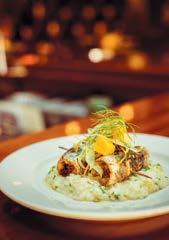
So the Geises added a fancy cocktail menu, full bar and a more elegant interior.
“Before it was sometimes so old fashioned, it felt like you were eating at your grandmother’s,” Paul says with a laugh.
Paul had lived in Italy as a child, and he opened Ristorante Avanti in part to provide an alternative to typical1980s Italian restaurant fare in America, which was limited to tomato-heavy pastas from Southern Italy. Remembering the risottos, polentas and seafood his mother and grandmother cooked from scratch, Paul wanted to redefine Italian food in Santa Cruz with fresh, wholesome recipes.
From the start—before organic was trendy—he and Cindy realized the importance of buying and cooking with locally cultivated, simple, and chemical-free ingredients. Today, they also buy pastured whole animals as much as possible for their meats and are big supporters of local farms.
“To me, every purchasing decision you make in your home or business is a political decision,” Paul says. “[We’re] trying to make the smallest possible impact on the earth by avoiding chemicals and by not buying stuff from China that has to be shipped all the way here. It’s still a real challenge and it’s more expensive, but for me it’s about doing the right thing.”
The result of the Geises’ efforts is a beloved local institution complete with regulars, a long-term staff and dedicated local partners.

“It’s fun to see farmers in here,” says Paul. “Billy Rodoni [of Rodoni Farms], who we get all of our Brussels sprouts from, he’ll come in here and get a Brussels sprouts salad. If your family has been growing Brussels sprouts for generations and you still come here and get Brussels sprouts, I think that’s a real compliment.”
The evening I visited the new Ristorante Avanti, it retained its familial vibe amidst chic fittings. Wooden tables, the tops of which are reclaimed redwood from Robert Mondavi wine tanks, were placed a spacious three to four feet apart, booths lined the walls and an island bar, also made from reclaimed redwood, stood in the center. A 12-or-so person party enjoyed the secluded outdoor patio, which kept their rambunctious conversations from disturbing the indoor guests.
I thought of Billy Rodoni while I munched a delicious Brussels sprouts salad, and imagined the beets of my red beet ravioli sleeping in a nearby field just hours prior.
The restaurant has changed, but its heart, its mission and its delicious food have been preserved.

April M. Short is a lifelong storyteller and award-winning journalist whose work is dedicated to the issues affecting Santa Cruz—her home of six years—and the surrounding region.
Ristorante Avanti • 1917 Mission St., Santa Cruz 831.427.0135 • ristoranteavanti.com


Miranda and Joe Schirmer of Santa Cruz’s family-owned Dirty Girl Produce organic farm have long been able to sell at farmers’ markets the tomatoes that their friends at Happy Girl Kitchen Co. can for them. Yet, because of the high cost of commercial kitchen space and complying with state regulations, they haven’t been able to sell Miranda Schirmer’s homemade strawberry jam.
That’s all changing. Thanks to the new California Homemade Food Act (AB 1616), which takes effect this winter, it will now be legal for the Schirmers and other home food artisans to prepare and sell certain non-potentially hazardous food products—jams, nuts, churros, breads and other goods that don’t involve cream or meat ingredients—to the local public.
“This enables our business to move in a direction we wouldn’t have been able to go: preserving what we’re growing, without having to take on a huge amount of risk,” says Miranda, who is excited to make use of the new law. “It’s a really practical law, and I think a lot of people are going to benefit.”
Miranda also believes the growth of new small-scale producers will be good for the environment and the community.
“This is giving the chance to microenterprises to pop up that otherwise wouldn’t,” she says. “And it can also be good for the price of food. If people don’t have to rent commercial space, they could charge a little bit less, and it might make their products more affordable.”
Act ($35,000 in the first year of operation, $50,000 two years after that).
While she says she admires the philosophy behind the act, she is wary of voicing full support. In her eyes, the new law could mean public health risks due to watered down regulations. She notes that she is required to undergo a yearly inspection for her commercial kitchen. By contrast, the law leaves whether to inspect home producers annually up to local heath departments, and does not require even an initial inspection of home producers that only sell direct to consumers, rather than through stores and other indirect outlets.
“There are many concerns regarding sanitation. In a home kitchen we behave in another manner than the professionalism of a commercial kitchen,” she says, describing herself cooking at home in her slippers, beer in one hand, blaring Jane’s Addiction and watching the family cat scuttle past.

“I go into a different mindset than when I’m in my professional kitchen with my three-door refrigerator, three sinks and drain in the middle of the floor,” she says.
“This is a great start and the idea is good, I just think the wording is watered down and needs some tweaking,” Stroup says.
Christina Oatfield, who worked with the Sustainable Economies Law Center to help the bill win passage, says it offers plenty of safety mechanisms.
The legislation requires home food producers to complete a course designed by California’s health department specifically for cottage food enterprises. Home producers will also have to label their goods as made in a home kitchen, and register with local health departments. And the bill’s writers consulted county and state environmental health officials throughout the entire year-and-a-half legislative process, and revised the bill numerous times in accordance with health officials’ input.
What’s more, some 30 other states already allow sales of homeproduced foods through their own cottage food laws.
“I think a lot of people were surprised that California was so late to adopt one of these laws, given how much activity there is going on here to stimulate local food economies,” Oatfield says. “I know consumers are excited for the additional options available to them—more small batches, more local food options and more opportunities to support local food producers in their communities. It’s definitely a reflection of this shifting attitude about how our food is produced in this state.”
April M. Short is a lifelong storyteller and award-winning journalist whose work is dedicated to the issues affecting Santa Cruz—her home of six years—and the surrounding region.
For more information on the California Homemade Food Act, go to www.theselc.org.


Carmel’s budding community of young, creative and sustainabilityminded restaurateurs has just expanded with the addition of Anna and Emanuele Bartolini and their La Balena, an informal nod to Northern Italy on Junipero Street between Fifth and Sixth.
The Bartolinis had been tossing around the idea of opening a restaurant for more than a decade. Emanuele’s grandparents, who were originally from Sardinia, had a restaurant in Florence years ago, and after emigrating from Italy to New York, Emanuele started work in the city’s restaurant world before he even knew English. By the time he left New York to move to Carmel, he was working as a senior manager at Del Posto, which is owned jointly by Mario Batali and Lidia and Joseph Bastianich and is one of the most highly regarded Italian restaurants in New York. In Carmel, he was most recently a general manager at Cantinetta Luca and helped open Salumeria Luca.
For Anna, a designer, opening La Balena—and getting to know the local farmers and other purveyors who will become a part of it— feeds a passion for supporting young people who farm and care about food the way that she does.
Anna and Emanuele strive to uphold the idea that food and wine taste better when served near where they are grown and when produced with ethical standards.

La Balena’s menu will be simple, seasonal and sourced from local organic suppliers as much as possible while remaining faithful to true Italian—and particularly Tuscan—cuisine.
The restaurant will have two chefs. Chef Salvatore Panzuto— who obtained a culinary degree from Naples’ Instituto Professionale Alberghiero di Stato—will prepare traditional, rustic food with the spirit of a classic Italian enoteca, or wine bar.
La Balena’s other chef will be Brad Briske, who is best known in the area for his turns as chef at Main Street Garden and Gabriella Café in Santa Cruz County as well as his farm-to-table meals. Briske, who most recently was hired by Carmel’s Casanova to take over their charcuterie program, will bring to La Balena his deep relationships with local organic farms and his creative style in cooking their bounty. Briske and the Bartolinis first met at Live Earth Farm in October, when Briske cooked a sensational dinner for Edible Monterey Bay’s 1st anniversary.
As this issue of Edible Monterey Bay went to press, the Bartolinis were planning for a late November opening and still working on the restaurant’s interior. But already, the former location of the Carmel Food Co. was showing plenty of character—and was reflecting the style and interests of its owners.
In evidence of the Bartolinis’ intent to run their business in as sustainable a manner as possible, the tables in the main dining room are made from reclaimed tropical hardwoods that were salvaged from trans-Pacific shipping crates. The cushioned wooden bench seating came from the local Habitat for Humanity store; the Bartolinis have refinished and re-upholstered them in two shades of coffee—one in the color of espresso and the other, caffè latte.
Hand-marbled papers, vintage postcards and posters, and some artwork that they collected during their time in Florence and its environs lend an authentic air to the space.
One of the pieces is the whale’s tail seen in the couple’s logo, which is by Florentine artist, Maurizio Bomberini. The restaurant’s name was inspired partly by the work, and partly by Emanuele’s deep passion for whale conservation.
Opening the restaurant and settling in Carmel are something of a homecoming for Anna, who as a child would travel from her home in Georgia to visit her grandmother’s first cousin, a Carmel resident, and could only dream of one day living here.
Camilla Mann is a food writer, photographer, adventurer and passionate cook based in Monterey.
La Balena • Junipero Street between Fifth and Sixth avenues, Carmel • 831.250.6295 • www.labalenacarmel.com.


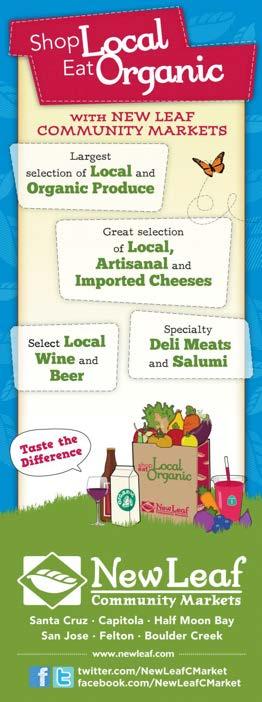

You can find it by wandering down Franklin Street until the path runs out of pavement and disappears into acres of growing fields, where row upon variegated row extend to the distant foothills, which seem to reach right up to God. You also can ask the folks in town how to get to San Juan Bautista’s Fault Line Restaurant and Gazebo, and they’ll point you toward “Edie’s place.” But even the best directions don’t guarantee you’ll be invited in for dinner.
The place, which had previously served Italian and German fare, was already named for its location when Edie Duncan bought the house, built by Donner Party survivors Patrick and Margaret Breen. Duncan, who was born in Poland and raised in Germany, had immigrated to San Francisco, ultimately settling in Santa Cruz. But a series of life changes and losses had sent her in search of a renewed sense of faith and a different point of view. She found both in the cottage, which is right next door to the Mission San Juan Bautista, and rests on the gap between the Pacific and North American plates, otherwise known as the San Andreas Fault.
“Mr. Patrick Breen lived in the corner of the living room for a long time,” says Duncan. “I could always tell where his ghost had been, by the shift in a spoon at the table or some other change in the room. But lately he seems to have departed.”
It wasn’t Duncan’s original plan to reopen the restaurant; her intention was just to live in the cottage. But then the earthquake of ’89 took down her fireplace and rearranged her life. “I was preparing food for the carpenters who were repairing the damage,” says Duncan, “when some people wandered in and asked if I was serving lunch. So, I said, ‘Sit down.’ After I thanked them for coming, they said, ‘This isn’t a restaurant? Well you need to open one; the food was really good.’ After that it kind of got out of hand.”
Duncan installed a polished-wood bar in the entry and shingled the walls—herself. She added a restroom and set up a workhorse of a kitchen, with eight gas burners, a Wolf grill and a wall of seriously seasoned pots and pans. Some 22 years later, she continues to cook, clean and serve by herself, as if hosting a few personal friends. By now, most customers are. And although she has served as many as 120 guests in one evening, she now sets six tables across the living room and hopes to serve just one or two.
“People ask when I’m open,” says Duncan, “and I tell them, ‘Whenever I feel like it.’ I only take reservations, and I don’t do kids, credit cards or coffee. Nobody wants coffee by someone who doesn’t

drink it. If they need coffee, I send them down the street to Vertigo Coffee.”
Dmitri Fridman, who owns Vertigo, recently celebrated his mother’s birthday at The Fault Line. “It is a unique experience you cannot find elsewhere,” he says. “Edie is such a great cook and makes her guests feel like they are dining in a private home. Anyone looking for a little adventure for the evening will find it there. She serves a wonderful meal in a pleasant atmosphere, which has a cool collection of Russian art and other works throughout the house. And she has a gorgeous gazebo out back.”
The Japanese-style structure was designed by a San Francisco landscape architect, the late Tommy Church, Duncan says. Guests may sit in its shade before dinner, enjoying a sip of something as well as views of San Juan Bautista State Park and the mission’s bell tower.
While Duncan’s dinners are generous, she doesn’t do dessert, and finds most people don’t miss it. She does introduce a little jar of chocolate-covered blueberries at the end of the meal, accompanied by the bill, along with a story or a joke she’s been saving. Ask her about “Timbuktu.”
“I don’t bake,” she says. “I can’t take orders from a recipe, and baking must be precise. I love cooking, but it has to be on my terms. I cook not by recipe but by taste. I fix food as I please, and let my guests decide.”
Fortunately for her guests, her tastes run both to the delicious and the healthful.

“I don’t do greasy food, and I use only fresh, organic, free-range food. It comes naturally to me. It doesn’t take a lot of experience to know that you put good things in to get good things out. I love fresh herbs, and I know how to make a good sauce. I don’t smother my food; I put just enough to dip, but people tend to lick my plates clean.”
Duncan’s menu shows up on an erasable whiteboard, listing her wild salmon, chicken schnitzel, rib eye steak or whatever she feels like making. Next to each listing she marks a few dots to signify how many servings remain available. She begins the meal with garlic bread and brie, followed by a fresh salad. Then she adds three vegetables to the entree — two green and another to add color to the plate. She’s known as the “spud queen” for her savory potatoes.
Duncan is attentive to her guests and sets the mood for the evening with their choice of music, preferably a little Leonard Cohen. Having installed big speakers in the yard, she can fill the air with his “Hallelujah,” and likely no one at the mission minds.
Lisa Crawford Watson lives with her family on the Monterey Peninsula, where she is a freelance writer and an instructor of writing and journalism at California State University Monterey Bay and Monterey Peninsula College.
The Fault Line Restaurant and Gazebo • 11 Franklin St., San Juan Bautista • 831.623.2117 • Open only by reservation; call at least a day in advance.


Santa Cruz’s bard of bubbles—very good ones, in fact
By Kurt Foeller Photography by Ted HolladayCalifornia’s sparkling wines need a dosage of originality.
That’s the conclusion I came to last holiday season, when I attended a tasting of 10 boutique producers that represented the diverse Champagne region of France. Each of these wines was so unique that I left the event questioning why I had never tasted a sparkling wine from California with such attributes.
I wondered: Why do most of our state’s premium offerings taste surprisingly like their equivalent foreign counterparts such as Moët & Chandon and Veuve Clicquot? Is there a single sparkler being produced in California today that has a distinctive personality that is not or could not be made anywhere else in the world? And if so, who are the people behind it? Is there a Randall Grahm or a Paul Draper of sparkling wine?
These were the questions that led me on a six-month quest to discover our country’s boutique sparkling wine producers. To be sure, there aren’t many to be found, but a few breadcrumb trails led me to the humble operation of Barry Jackson of Equinox Champagne Cellars in Santa Cruz.
“Economically it doesn’t make sense to make small volumes of premium sparkling wine,” he says. “So you are either operating at the scale of Iron Horse or above, or else you do it because it’s your passion. I made a few hundred cases last year, so you can easily figure which camp I’m in.”
Barry is a different camper indeed. He’s not the suited guy leading a tasting in the front of the Champagne house, and scolding you for not holding your flute glass properly. Instead, you’ll likely find Barry in jeans and a T-shirt, crushing the grapes himself. And he’s not pretentious at all. He wants you to be really happy with the wine you’re drinking now. Even if it’s not his.
By day, he makes award-winning still wines for his value-priced Bartolo brand and many storied producers in the Santa Cruz and Monterey regions such as Kathryn Kennedy. By night, he is something of a local bard of bubbles, speaking poetically about the terroir of the Chardonnay and Pinot Noir that go into his sparkling wines, and how he’s experimenting with extended tirage—long periods of futzing and aging on yeast to add even more distinction to them.
“Still wines are simple compared to sparkling wines made in the méthode champenoise tradition,” says Jackson. “With still wines, you
pick perfectly ripe fruit, you make the wine with as little human intervention as possible, and get the hell out of Mother Nature’s way. Sparkling is nearly the opposite. You harvest the grapes early when they taste like little balls of acid, then put them through an elaborate process, and must remain committed to constant tinkering over years of time in order to make a superior product.”
This complex process—and the time it takes to complete it— is precisely why there aren’t a lot of small producers of sparkling wine in our country today. “It’s a money pit, and an obsession,” Jackson admits. What’s more, most winemakers today have no experience with sparkling. And that is why when wineries like Bonny Doon decide to offer a sparkling Albarino, they outsource it to Jackson rather than make it in-house.
If you are looking to experience something truly different—and local—in sparkling wines this holiday season, I strongly recommend that you check out Barry Jackson and his Equinox line sometime soon. In the hundreds of Champagnes and sparkling wines that I have tried from all over the world, I can vouch that Jackson’s bubblies are extremely well made and have tropical flavors and complex toasty elements that I have never experienced before. The Prince of Pinot blog is equally enthusiastic about Equinox, and one K&L Wines review calls his Blanc de Blancs “a national treasure.”
However, you should be forewarned: Equinox wines are not cheap. The non-vintage brut is priced at $45 and his recently released 1998 vintage is $75. Comparatively speaking, the standard non-vintage Veuve Clicquot (orange label) is $45, and it’s a threeyear-old wine. But Jackson’s NV Brut is eight years old, and his 1998…goes to 11. So if you consider Equinox’s age and craft, I’d argue you’ve stumbled on a bargain.
Kurt Foeller is a lifestyle and business writer based in San Francisco. He aspires to be the first non-professional contestant on TV Food Network’s Chopped. His favorite wines at the moment are whites from Italy’s Alto Adige region.
For a sparkling wine primer, go to the online version of this issue on our website, www.ediblemontereybay.com.



Equinox Champagne Cellars • 427 Swift St., Unit C, Santa Cruz 831.423.3000 • equinoxwine.com

“Economically it doesn’t make sense to make small volumes of premium sparkling wine. So you are either operating at the scale of Iron Horse or above, or else you do it because it’s your passion.”

Fruits: Apples • Asian Pears • Avocados Grapefruit • Grapes • Guavas • Kiwis • Kumquats Lemons • Limes • Mandarins • Oranges • Pears Persimmons • Pomegranates * • Pomelos
Vegetables: Artichokes * • Arugula • Asparagus ** Beets • Bok Choy • Broccoli • Broccoli Raab Brussels Sprouts • Burdock • Cabbage • Cardoons Carrots • Cauliflower • Celeriac • Celery • Chard Chicory • Collards • Cress • Dandelion • Endive Fava Greens • Fennel • Garlic • Horseradish • Kale Kohlrabi • Leeks • Mushrooms • Mustard Greens Nettles • Onions • Orach • Oranges • Parsnips Potatoes • Radishes • Rutabagas • Salsify * Shallots • Spinach • Sprouts • Winter Squash Sunchokes • Sweet Potatoes • Turnips
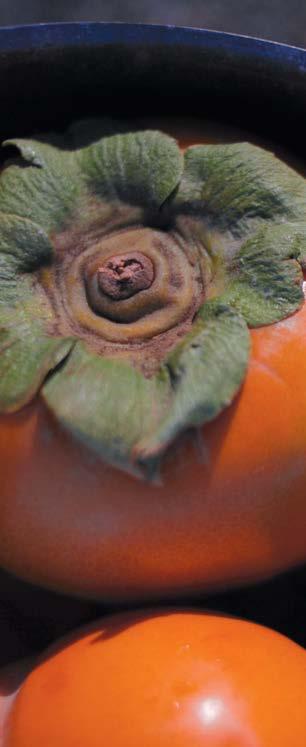
Fish: Abalone (farmed) • Dungeness Crab, Lingcod (Rod and Reel)# • Rock Cod (Rockfish, Rod and Reel, Purse Seine, Trap)# • Sablefish (Black Cod, Longline, Pots)# • Sanddabs (Pacific)# Sardines (Pacific) • Sole (Dover and Petrale, Longline, Rod and Reel)# • Spot Prawns# Squid (Market, Purse Seine)#
* December only ** February only # Rated “Good Alternative” by the Monterey Bay Aquarium’s Seafood Watch. All other seafood listed is rated “Best Choice.” See www.montereybayaquarium.org/cr/seafoodwatch.aspx for more information.
It is very appropriate that I bite into my first Fuyu persimmon of the season as I sit down to write about them. I add some dry, aged goat cheese and oil-cured olives to the mix, and persimmon inspiration begins to bubble to the surface. What’s not to love about these versatile and tasty fruits that are available throughout the winter months?
Persimmon trees like both mild summer months and mild winters, so our region is a perfect place for growing them. On Monterey Bay, many country properties with a little extra land are home to persimmon trees. Take Carmel Valley for instance; in the winter, you can drive through and see the unpicked, bright orange, acorn-shaped fruit hanging in an amazing display of color long after the leaves have fallen off. I like to fantasize that Carmel Valley cowboys made brandy out of them in the old days, to keep them warm on horseback during cold winter days.
Whether to pick the fruit or keep them on the tree can be a hard decision. I’m guilty of letting the fruit hang on the trees so that I can gaze through my bedroom window at the sight of them brightening a dark winter morning with their orange glow.
The botanical genus of an edible persimmon tree is Diospyros, meaning “divine fruit,” and botanically speaking, persimmon fruits are actually berries. The word persimmon comes from the American Indian word putchamin, which means “dried fruit,” probably due to the Algonquin tribe’s practice of drying them for sustenance in the winter.
The first European to mention trying the fruit was explorer Don Fernando de Soto in 1539 when he learned about it from Indians in Florida. However, the first descriptive diary entry came from Captain John Smith during the 17th century, and noted “if it not be ripe it will draw a man’s mouth awry with much torment, but when it is ripe, it is as delicious as an apricock.” (Apricock was the old name for apricot.)
Capt. Smith must have been talking about an astringent variety, such as the Japanese cultivar Hachiya, which is commonly available in our local markets.
Hachiya fruit ranges in size from six ounces to one pound and boasts a robust shape encased in a bright, pumpkin-orange skin. To avoid the astringency of unripe Hachiya, the variety needs to be in a pre-exploding state of ripeness—look for a very thin skin and insides that resemble thick jelly, sweet and slightly spicy with a substantial pulp. And by the time they are ripe, they need to be worked
with quickly, as it is a fine line between perfectly edible and rotting persimmon fruit.
But the rewards are worth paying attention. Ripe Hachiya varieties can be eaten right out of the skins with a spoon, or by removing the calyx (the dry leaf-like part on the top of the fruit) and eating from the inside out. They are often baked into breads and cookies or cooked into seasonal puddings. Most common is a steamed pudding originating in the Midwest, which is topped with brandy butter and crème Anglaise—a sugar, egg yolk, cream and vanilla mixture. The consistency of this pudding is like pumpkin pie, but looks like a brownie and tastes like something in between the two. (More on cooking with persimmons later.)
The other variety grown locally is the Fuyu persimmon, which is not astringent and is different from the Hachiya in other ways. Smaller in size, squat like a little pumpkin and resembling an orange heirloom tomato, Fuyu persimmons can be eaten right off the tree in a crunchy state once the fruit is completely orange. They are sweet and mild, and eaten as you would an apple. Other crisp varieties similar to Fuyu are Gosho, Imoto, Izu, Jiro, Maekawa Jiro and Suruga. (The prevalence of Japanese names reflects that Japan—along with China and Korea—are the world’s largest producers of persimmons.)
There is also a black variety of persimmons, native to Mexico, making a rare appearance at farmers’ markets. It is known as chocolate or coffee cake persimmon in the States and is sometimes called black sapote (although there is no relation to the true tropical sapote fruit). The black persimmon looks like a cross between the Hachiya and the Fuyu in shape, but needs to be fully ripe like the Hachiya to be edible.
Not all persimmon trees bear fruit. A member of the same botanic family, Ebenaceae, as ebony, they are sometimes used for their wood, most often in making percussion instruments like drumsticks and wooden flutes, or, more recently, long bows for archery.
Not only are persimmons beautiful, they are also delicious, and there are many different ways to prepare them. The Hachiya and the Fuyu lend themselves best to very different culinary adventures, however.
Fuyus add color to your holiday spread, and are great accompaniments to cheese platters, complementing the strong flavors with their slightly sweet and crisp flesh. They are a tasty and crunchy accent to sandwiches of all kinds, my favorite being an addition to a
soft herbed goat cheese and roasted pork loin panini. Fuyus are also the persimmons that are sliced to go into salads and garnish desserts. Persimmon, fennel, kale and quinoa salad never disappoints.
Hachiyas are good for anything dessert-oriented. Start by preparing a naturally gelatinous, sweet base from the Hachiyas by cooking down the pulp of eight Hachiyas for 12 hours in a crock pot, stirring occasionally and then adding some vanilla, agave syrup or honey, cinnamon, and the juice and zest of two lemons. This base, or persimmon “cook-down,” can be baked into breads and puddings, used to cook meats such as pork roasts and goat, or simply spread on toast as persimmon butter. The pulp can also be a base for seasonal beer making or left to ferment into probiotic fruit vinegar.
Last season I was turned on to traditionally dried Hachiya persimmons, a labor-intensive technique practiced by Japanese farmers and offered by Hamada Farms, a family farm that sells at the Old Monterey Market Place on Alvarado Street Tuesday afternoons. Cliff Hamada was kind enough to explain the process of drying whole persimmons in the old-world Japanese style that the Hamadas have been practicing for more than 100 years and three generations.
“First you start with Hachiya persimmons that are just breaking color and are rock-hard,” he explained. “When you harvest from the tree, be sure to cut the stem in a ‘T’—this is how the fruit will hang on the string to dry. Take a potato peeler, peel off the first layer of skin. Hang the persimmons on a string, in the sun or in a warm kitchen, ensuring that they don’t touch and air can circulate. Massage each persimmon to break up the fibers at least twice a week for 2–3 weeks until they are dry. Store in a cool place once they are dried.”
I soon found myself getting addicted to the massaged, dried Hachiya, which I dipped whole in some quality black coffee for a sweet breakfast treat.
Chef Cal Stamenov, executive chef at Marinus and Wickets at Bernardus Lodge in Carmel Valley, shared with me his favorite way to eat a Hachiya persimmon—and it is also one of the easiest preparations you’ll find.
“Harvest them with the stem attached after they are fully ripe and are like a water balloon, and put them in the freezer overnight,”
Stamenov says. “Remove them when they are frosty for a delicious dessert.”

Persimmons contain high levels of fiber, and significant amounts of essential minerals and antioxidants. They are also rich in vitamin C, potassium and beta-carotene. Research shows that eating persimmons regulates how the body deals with fat, and may help prevent heart disease. In Chinese medicine, they are known to regulate chi, or energy.
Persimmon trees are planted 15 to 20 feet apart and prefer to be protected from wind and extreme temperatures. Wonderfully drought tolerant once established, persimmons are not susceptible to disease or pests unless the tree becomes weak from poor care. Persimmon trees start to produce fruit well after they are established—around their sixth year. Trees can grow to 25 feet, and pruning can keep the tree a manageable size and the yield consistent year to year.
This year, I’m contemplating not leaving the persimmons on the tree all winter for visual candy to be enjoyed out my bedroom window. Instead, I think I will harvest them early, bring them in from the cold and show them a little love—maybe even a few weekly massages.
RECIPES: See recipe for Persimmon Pudding Cake, opposite, and Dungeness Crab Salad with Persimmon Carpaccio and Yuzu Vinaigrette on p. 22. A recipe for Hachiya Persimmon Vinaigrette may be found under the “Recipes” tab on our website, www.ediblemontereybay.com.
Jamie Collins of Serendipity Farms has been growing organic row crops at the mouth of Carmel Valley for more than 10 years. She distributes her produce through a CSA, u-picks and farmers’ markets.


Courtesy Ben Spungin, pastry chef, Bernardus Lodge in Carmel Valley
1½ cups raisins
1 cup plus 2 tablespoons brandy 2 cups persimmon pulp (from Hachiya persimmons)
½ cup sugar
¾ cup plus 3 tablespoons walnuts, chopped 1 pinch cloves
1 pinch nutmeg
1 teaspoon salt
1 teaspoon baking soda
1 cup milk
4 tablespoons egg whites
1 handful sugar
Brandy Sauce
1cup butter, melted 1 ½ cup brown sugar
1cup cream ½ cup brandy Pinch of salt
In a small glass or ceramic bowl, combine the raisins with the brandy, making sure all raisins are submerged. Cover and let sit at room temperature for 3 hours or preferably overnight.
Heat oven to 325° F. Butter and lightly flour a bundt pan; set aside.
Purée the persimmon pulp in a blender, then strain into a large bowl, using the bottom of a sturdy ladle to force as much through a strainer as possible. Add the sugar, vanilla, cloves and nutmeg, stirring well until blended. Stir in the walnuts and the raisin-brandy mixture. Combine the baking soda and salt and gradually add the persimmon mixture, stirring until well mixed. Gradually add the milk, blending well, then set aside.
Pour the egg whites into a small mixing bowl. Place an electric mixer onto them and set the speed at low. Beat the eggs for about 30 seconds, increasing speed and adding sugar every 30 seconds until stiff peaks begin to form.
Lightly fold the egg white mixture into the persimmon mixture just until barely blended. Gently spoon the batter into the bundt pan. Leave in the oven for 1 hour to 1½ hours. Remove from oven and let cool to room temperature, for about an hour. While cake is cooling, make Brandy Sauce: Whisk brown sugar into butter, boil for 1 minute and turn off heat. Add brandy, salt and cream, whisking until smooth. Slice cake at 90 degrees, spoon brandy sauce onto the slice and then sprinkle nutmeg over the sauce. Serve immediately.
In this photograph, the Persimmon Pudding Cake is served with golden raisins, almond streusel, whipped crème fraîche, yogurt-huckleberry sorbet, red wood sorrel and sliced and puréed Fuyu persimmons.
Serves 6
Finely grated zest of 2 yuzu or limes
2 teaspoons fresh lemon juice, preferably Meyer 1 tablespoon yuzu or lime juice
3 tablespoons fruity extra-virgin olive oil
Sea salt and freshly ground pepper to taste
Make the vinaigrette first, so the acidity and flavors have time to mellow while you prepare the other components of the salad. Combine the zest, juices and a pinch of salt and pepper in a small bowl. Slowly whisk in the olive oil. Taste and adjust the seasoning. If you’re not using yuzu juice, increase the amount of lemon juice by 1 teaspoon to approximate the same acidity level, or add a teaspoon of tangerine juice. Set aside at room temperature.
2 teaspoons fresh ginger, finely minced 3 tablespoons fresh lime juice
2 teaspoons soy sauce 1 large egg yolk
¾ cup canola oil
Kosher salt and ground white pepper to taste
Combine the ginger, lime juice, soy and egg yolk in a blender or small food processor. With the machine running, slowly add the oil in a thin, steady stream until the sauce thickens. The aioli should be the consistency of a creamy salad dressing such as ranch or Caesar. Season to taste with salt and pepper. The aioli is meant to have high acidity to balance the sweetness of the crab and persimmon. Keep refrigerated while you proceed with the recipe; the aioli can be made 1 day in advance.
4 cooked Dungeness crabs, about 1½ pounds each
4 Kaffir lime leaves
4 strips candied yuzu, optional
3 ripe Hachiya persimmons
¼ cup microgreens or radish sprouts (garnish)
4 fresh chives (garnish)
Remove the 2 claws and the 4 largest (front) legs from each crab. For an artful presentation, the crabmeat should be in large pieces, so save the remaining, smaller crab legs and the meat from the bod-
ies for another use (combine with unused Ginger Aioli, for instance). Cut off the small knuckles at the joint where they attach to the main claw; save these small pieces for another use. Using a wooden mallet or small hammer, very lightly tap the shells of the crab claws until they crack in several places, taking care not to smash the meat in the process. Bend each small pincer claw away from its larger counterpart until it snaps. Then, very gently twist it in order to release the tiny piece of crab inside the shell. Carefully extract the claw meat from the broken shells, hopefully with the pincer claws still attached. This can be tricky, so don’t worry if the tiny pincer meat does not release from the shell or breaks in the process.
Crab legs have many small sections and removing the meat in neat pieces can be difficult. Use only the largest segments, those closest to the body. Cut off the lower, smaller pieces at the first joint and save for another use. Tap the shells in the same manner as for the claws and carefully extract the fingers of meat. Each salad should have 6 whole pieces of crab.
Slice the Kaffir leaves into a very thin chiffonade, then cut the strips crosswise into a dice so finely that it resembles particles of salt (this step can’t be accomplished successfully in a food processor). Set aside.
If using the candied yuzu, cut each strip into a very tiny dice; set aside.
Place the crab in a medium bowl and sprinkle with a pinch of salt and pepper. Whisk the vinaigrette to re-emulsify it, then pour it over the crab. Add half of the Kaffir leaves and all of the candied yuzu to the bowl. Very gently blend the ingredients with a rubber spatula, taking care not to break the crab pieces.
Cut off and discard the top, stem end of the persimmons. Remove the skin from the fruit with a small, sharp knife or a vegetable peeler. Cut the persimmons crosswise into thin slices, 1⁄8- to ¼-inch thick. With Hachiya persimmons, the variety I recommend for this salad, it is best to slice them by hand as they are extremely soft when ripe. If you use Fuyu persimmons, you can slice them on a mandoline, if you wish, because this variety is firm when ripe. In any case, the slices should be no thinner than 1⁄8 inch or they will stick to the plate.
Use large, flat white or black dinner plates for the presentation to highlight the dramatic color of the persimmons. Place a dollop of Ginger Aioli in the center of each plate. Using the back of a spoon, spread the sauce into a 3-inch circle. Arrange 5 slices of persimmon on top of the sauce, overlapping each piece slightly to create a circle of fruit. The aioli will be covered, except for a small circle in the center. Keep the circle of fruit at least an inch away from the edge of the plate for the best effect. A band of empty plate centers and showcases your presentation.

Place 3 pieces of crab on top of the Persimmon Carpaccio in the center of the circle. Use any less than perfect pieces on the bottom. Top with 3 more fingers of crab, setting these at a 90-degree angle to the pieces on the bottom. Sprinkle just the crab meat with the remaining Kaffir leaves (you don’t want to spoil the pristine perfection of the persimmon slices). Top with a sprinkling of microgreens.
If you wish to further garnish the dish, cut a 3-inch length from the center section of a firm, medium-size chive. Hold the chive in the air, grasping the bottom half-inch of the stem. With a small, very sharp knife, cut the chive in half lengthwise, starting from the point above your fingers and moving up the stem. Turn the chive 90-degrees and slit again, so that chive falls into 4 thin ribbons, still attached at the bottom. Alternately, place the chive on a cutting board and carefully slit the stem in half lengthwise, leaving the bottom half-inch intact. Rotate the chive 90 degrees, and make a second lengthwise cut, so the stem is now slit into 4 thin lengths. Drape the chive over the top of the salad.


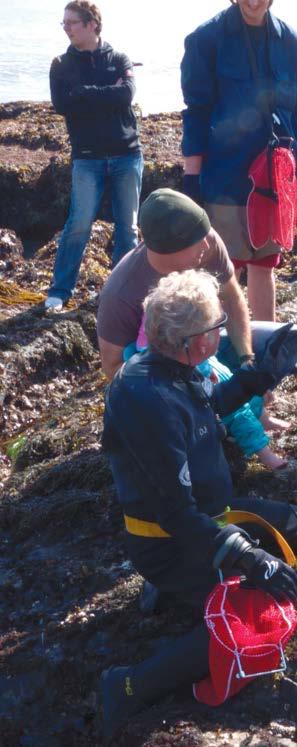 A Santa Cruz legend shares his secrets
By Deborah Luhrman
A Santa Cruz legend shares his secrets
By Deborah Luhrman
Dennis Judson felt the pull of the tides and the seduction of the surf from an early age. At just eight years old, he would ride his bike out to Manhattan Beach in Southern California and jump right in.
“L.A. was magical back in the 1940s and ’50s,” he recalls. “It was like a giant swamp. In the wintertime it would flood, and we would get lakes and rivers. There were empty fields, meadows and dairy farms, and they put our housing tract right in the middle of it.”
The budding forager caught crawdads in the rivers, fished for blue gill in the lakes and captured abalone and lobster at the shore, and then he learned to dive.
“A diver owed my dad some money, so he said, ‘teach my son to dive and we’ll call it even,’” he remembers, adding that the diver would also teach him how to make his own wetsuit.
“You couldn’t buy wetsuits back then, but every dive shop had rolls of neoprene and patterns. So you just cut one out with scissors and glued it together. I had to carry glue around with me because mine always broke,” he says, laughing.
Judson’s mother wasn’t quite as enamored with the sea. “She liked fish sticks and believed that all seafood needed to be frozen,” he says. “So by the time my catch was served, it usually had freezer burn and looked pretty ugly.”
But on a Boy Scout backpacking trip, Judson discovered the joys of cooking and eating fresh-caught trout. He’s been cooking fresh seafood ever since.

In college it was a matter of survival. Judson was a biology major at Humboldt State and recalls, “I barely made enough money in the summer to make it through the school year, so we fished for salmon and tuna and went crabbing. We foraged to stay alive, but it was good food.” He also learned the Native American way to bake a whole salmon, wrapped in and stuffed with laminaria—a thin, delicate kelp.
Judson was among the first graduate students to attend UC Santa Cruz in the 1960s and has made Santa Cruz his home ever since. He’s become an important part of the town’s legendary surf culture and runs a scuba diving and sea kayak shop called Adventure Sports Unlimited in the Old Sash Mill. For the past 27 years, he has been organizing the Santa Cruz PaddleFest competition for surf kayaking at Steamer Lane—a sport at which he excels. Judson occasionally offers beginner’s classes in “Seafood Foraging,” and that’s how I met him.
Motivated by my own memories of prying mussels from the rocks at Twin Lakes beach and steaming them over a bonfire in my youth, I headed for the preforaging lecture on a rainy winter night.
Judson clearly relished getting back to his academic roots and teaching our group of about 15 students what to look for in the tide pools and on the rocks.
He taught us that limpets and sea snails can be found in areas that are not submerged but get good doses of sea spray. We learned that mussels, gooseneck barnacles and several types of sea vegetables are found in the upper tidal zone—which is out of the water 75% of the time. Other treasures like abalone and sea urchins are found in the low tide zone—which is submerged most of the time.
He sped through the material, but fortunately there were handouts to study at home. What really stuck in my mind was his warning about the sea palm or postelsia palmaeformis—a plant considered a delicacy but protected under California Fish and Game regulations.
“Sea palm only grows on the top of rocks where the waves are especially intense,” he told us. “So if you see sea palm growing, beware! You might want to move.”
He also warned, “If you don’t want to get wet, you’re not going to be a happy forager.”
Fortunately, the next day dawned clear. We all made our way up to Pigeon Point to start foraging. Judson holds his classes during es-
pecially low tides so that foragers can observe and collect as much as possible, but foraging can be done during any negative tide. (See “Explore” box at end of story for a link to a tide table.) You do need a fishing license, however; they are sold for $40 at sporting goods stores and are good for a year.
We waded through slippery tide pools and snipped gingerly at all sorts of sea plants, which Judson called vegetables. The objective was to get a variety of colors and textures for a salad to be served at the forager’s feast after the excursion. One of the most prized vegetables was lacy purple porphyra, also known as nori and used to wrap sushi. It’s packed with nutrients and flavor.
We also searched for a brown kelp called alaria, valued for its ribs that can be pickled or served like asparagus, and for iridaea—a broad-leafed, green-red sea vegetable with an iridescent sheen that is good cut into matchstick-size pieces and pickled like the Korean condiment kimchi.
After clambering over rocky outcroppings from cove to cove, we finally got to a big rock that appears far out to sea when the tide is in. Our fearless leader nimbly climbed to the ocean side, with some of us trailing behind and others choosing to stay at the tide pools to collect limpets and vegetables.
There we found ourselves standing on an enormous mussel bed, so we pulled out prying tools made from old butter knives and began collecting. It was hard work loosening the first mollusks, but being outdoors and soaking wet in the heavenly sea spray was worth it.
Then as freezing waves lapped at my feet on the jagged edge I spied it—sea palm—right next to my narrow perch. Which means “Beware! Maybe you should move on.” But mussel foraging is kind of like mushroom hunting or like gold fever—once you get started, it’s hard to stop.
We filled our pouches with all the mussels we could carry—well under the 10 pound-per-person limit—and started back, scraping knees and fingers on the sharp rocks.
On the beach, Judson popped open a bottle of champagne and urged us to try sea urchin scooped straight from the shell. It’s also known as uni and considered a real delicacy by the Japanese and the French. It tastes of the sea and has a subtle flavor, like lobster but with a soft, smooth texture.
Seafood foraging takes place primarily in the winter. Mussels and other bivalves are quarantined from May 1 to October 31 because they are potentially toxic during the summer months when the seas warm up and algae blooms take place. Even in winter, Judson recommends foraging along the coast north of Santa Cruz at places like Pigeon Point, Scotts Creek or Davenport Landing or in Big Sur around Garrapata Creek rather than along the shores within Monterey Bay. This is because big waves in the open ocean help keep the water clean and the foraged shellfish—which are natural water filters and can accumulate impurities—healthy.
Seafood foragers sometimes have other concerns—that they may be harming the natural environment, for example. In fact, Judson urges his students to treat the ocean as if it were their own garden, taking only the fruits that they intend to eat themselves and leaving enough for the next day and for the future.
“Then as freezing waves lapped at my feet on the jagged edge I spied it—sea palm—right next to my narrow perch. Which means “Beware! Maybe you should move on.”

If you’re curious to try seaweed, unusual shellfish and other delicacies that can be foraged along our coast—but lack the expertise to collect your own—you’ll be curious about what Post Ranch Inn’s Sierra Mar has in store for you.
Just as this issue of Edible Monterey Bay went to press in November, Executive Chef John Cox was expected to launch a new eight-course Taste of Big Sur menu, with which he intends to reflect the flavors of Post Ranch’s spectacular location as never before. The menu will be prepared almost exclusively with foraged and other local ingredients—and is ultimately aimed at elevating Sierra Mar’s cuisine to the same Top-10-in-the-world status as the restaurant’s views.
“Sierra Mar has always been known for excellent food and an unparalleled view,” Cox says. “But by creating a unique menu that is not only inspired by the natural surroundings but also can only exist in Big Sur, and presenting it in as awe inspiring a setting as our dining room, there is no reason Sierra Mar shouldn’t be able to compete with the world’s top restaurants.”
To that end, Cox—who has long been an avid forager (See EMB Spring 2012, p. 60 for his piece on foraging in our region) and daringly creative chef—has been drawing inspiration from Native American and early pioneer practices, as well as the land and sea itself to come up with his new dishes.
Among the foraged fare that he’s already developed are a dish of local wild halibut with wild fennel pollen and dulce, and another featuring abalone (farm-raised, as foraged local abalone cannot be sold commercially) that has been wrapped in kelp and smoked over a Big Sur driftwood fire. After smoking the abalone, Cox then slices it razor thin, and serves it with a tangle of carefully prepared and surprisingly beautiful local seaweed varieties, including ogo, dulce, sea lettuce, sea grapes and Turkish towel.
And for those who aren’t drawn to the sea, Cox has several dishes made from exotic foraged foods from the land, including yucca blossoms, madrone berries and miner’s lettuce.
One especially inspired dish is a riff on the affinity wild boar have for Bay and Redwood forests. The dish combines boar tenderloins brined with bay leaves, a sauce made from bay fruit and another made from ground bay nuts, cocoa butter and guajillo chiles.
Cox is also experimenting with some “really crazy” ideas that he’s not quite ready to share, but if his past creations are any indication, they should be incredibly inventive and delicious.
To collaborate on all of this, Cox has recruited additional talent including Jacob Pilarski, formerly the sous chef at David Kinch’s Manresa, which is also well-known for seeking to convey a sense of place in its cuisine, and sous chef Willy Ono, who most recently worked for some of the best restaurants in the world, including Spain’s Mugaritz and Denmark’s NOMA (which is known for its foraging) and Relae Restaurant. Additionally, he has plans underway to supplement his organic garden with chicken coops and beehives, and has hired Fiona Bond, previously a garden manager at Love Apple Farm, which grows Kinch’s produce, to oversee it all.
The bad news is that the eight-course menu will cost a rarified $160—even more than the $110 price tag of the restaurant’s existing four-course menu, which will continue alongside the eight-course menu.
But Cox, who rejoined Post Ranch Inn during last summer after stints with other Passport properties in Hawaii and most recently, three years with Casanova and La Bicyclette in Carmel, also came up with the brilliant idea of adding to Sierra Mar’s previous lunch of wagyu burgers and salads a three-course taste of the refined dishes on the restaurant’s dinner menu for just $40.
And the view is the same as at dinner. —SW
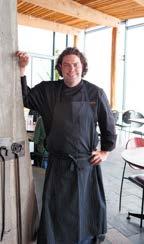
Foraged local ocean delicacies dominate new menu at Post Ranch Inn’s
Chef John Cox is preparing to amaze youPhotos by Melissa Barnes
Clockwise from bottom left, this page: hiking to the tide pools, sea lettuce, sea urchins, limpets, Dennis Judson helping a student pick mussels, red weed, gooseneck barnacle, barbecuing mussels, Judson harvesting an urchin.

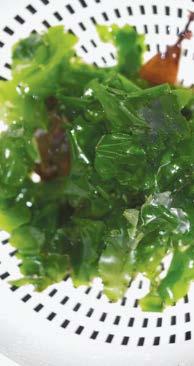
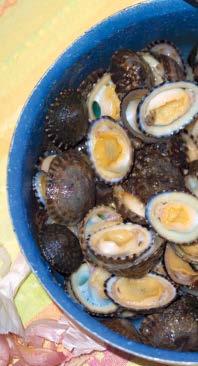
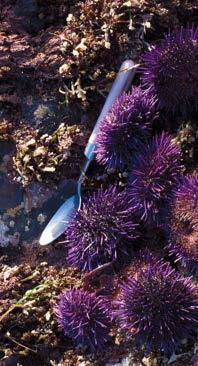


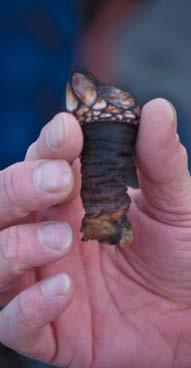

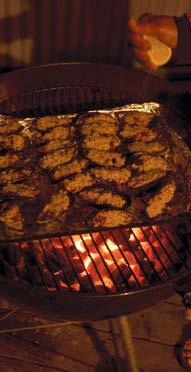
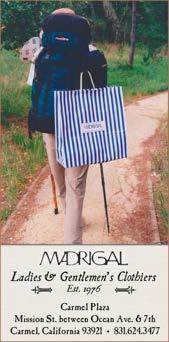
Grand Marnier Mussel Stew was a recipe that was created for a contest between San Francisco chefs for alternate food creations for Thanksgiving. This mussel stew is an alternative to traditional clam chowder.
The recipe is in two movements: 1) a fumet with mussels in alcohol and 2) cream-based soup with potatoes and vegetables.
4 tablespoons butter
½ cup bacon, salt pork or barbecued tofu, chopped ½ cup each carrots, celery, onions, mushrooms and parsley, chopped finely 2 cloves garlic, smashed and chopped

1 tablespoon oregano
1 tablespoon thyme Dash saffron, curry and fresh cracked pepper
5 pounds mussels 1 cup brandy 1 cup Grand Marnier
Melt the butter in a saucepan. Add the spices and meat or meat substitute. Sauté the vegetables in descending order of toughness. When onions are clear and carrots are soft, dump in mussels. Don’t bother to clean the shells, as this adds more flavor. Pour in liquor and cover, to steam. Remove mussels when shells open and meat begins to coalesce. Don’t overcook. Place in a pan to cool. Allow fumet to simmer and reduce by half. Remove mussel meat from shells. Discard beard and save meat.
4 ounces butter
1 slice bacon, salt pork or barbecued tofu, chopped 2 cups carrots, finely grated 2 cups celery, onions, Portobello mushrooms, parsley and cilantro, chopped coarsely 3 cloves garlic, smashed and chopped 2 tablespoons oregano
2 tablespoons thyme 2 cups 1-inch thick, boiled red potatoes, al dente, chopped 2 quarts whipping cream, half-and-half or nondairy creamer
1 teaspoon curry
1 teaspoon saffron
1 teaspoon pepper ½ cup flour
Melt butter in a 1-gallon soup pot. Put in meat or meat substitute and cook until ham meat is clear. Sauté vegetables, except parsley and cilantro, in descending order of hardness. Mix in spices. When onions are clear, mix in the flour. When flour is well mixed, add cream and mix until smooth. Add boiled potatoes.
When Mussel Fumet is to the desired concentration, filter it into this soup mixture. Do not pour in the last of it because it contains the enemy: sand. Add parsley and cilantro at the end. As you serve, add 2 tablespoons of mussel meat to each portion.
“My objective is to show people that the ocean is a lovely place to be and that you have to be nice to this space. The more people appreciate it, the more they will take care of it,” he says. “An enlightened forager understands the limits so they don’t overdo it. They don’t trade on it. They just eat it.”
The third part of the foraging class involved preparing all the seafood that we had collected. After a glass of wine and a dip in the hot tub, we set to work chopping onions and cleaning our haul. Recipes have been honed over several decades to ensure that gourmet quality food can be cooked over an open fire on the beach or, in our case, on camping stoves poolside at the dive shop.
For years Judson ran month-long diving camps to Danzante Island in the Sea of Cortez off the coast of Loreto in Baja California. His rule was and still is: Everybody cooks or they don’t eat. So his classes are as much about cooking as they are about foraging.
“Everybody has to learn to clean and chop garlic and make a fumet,” or concentrated fish stock, he says. “Capturing the essence of the flavor of the seafood in a broth, making fumets is what this whole thing is about.”
My partner and I volunteered to prepare Grand Marnier Mussel Stew, from Judson’s recipe. Others prepared Tuscan-style Stuffed Mussels, Coconut Curry Baked Mussels, pickled kelp, a sea vegetable salad described as “a crescendo of textures and colors” and then there was my favorite dish, Limpet Pasta—who knew those little things could be so tasty. Recipes can be found on the EMB website.
There are two Santa Cruz classes scheduled for 2013: “Seafood Foraging” in March and “Kelp Pickling” in April. (See “Explore” box on p. 31.) Judson is also leading a dive tour in August to visit the unspoiled coral reefs of Papua, New Guinea, for the fourth time. And if that’s not enough, he is trying out for the U.S. West Coast team that will compete in the World Surf Kayaking Championships in Australia in June.
Now 70 years old, Dennis Judson shows no signs of slowing down. He’s living proof of the health benefits that can be derived from eating fresh seafood, sea vegetable salads and spending your life in the ocean. And maybe that’s the greatest secret he has to share.
For related story, see p. 27; for recipe for Grand Marnier Mussel Stew, see opposite; for recipes for Mussel Pasta and Fried Sweet Kelp Chips, go to the “RECIPES” tab at www.ediblemontereybay.com.
Adventure Sports Unlimited
303 Potrero St., #15, Santa Cruz www.asudoit.com
Seafood Foraging Class March 8-10

Kelp Pickling April 26-28
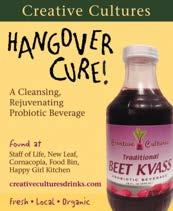
Tide tables available at www.tidesandcurrents.noaa.gov and at sporting goods stores that sell fishing licenses.


If you are interested in where the organic movement is headed, there’s no better place to find out than at the annual EcoFarm Conference. Now in its 33rd year, the 4-day gathering of organic farmers, ranchers, food activists, researchers, analysts and members of the general public takes place at Asilomar Conference Grounds in Pacific Grove from January 23 to 26. It is the oldest and largest sustainable ag event in the West.
“There is evidence that organic or ecological farming is the quickest, safest, most resilient and reliable way to produce food for people around the world,” says Ken Dickerson, executive director of the Soquel-based Ecological Farming Association that organizes the conference. “A lot has already been figured out, but there is certainly room to innovate and room to advance the technical approaches. That’s what our conference is all about.”
Cross-pollinating ideas is the goal of Dickerson and conference planner Liz Birnbaum, who have developed dozens of meetings around the conference theme, Feed the world you want to live in.
“Our community has been dreaming an alternative food and farming system into existence—one that is healthful, safe and just,” says Dickerson. “So holding that vision in our minds, the conference is about how we make it a reality in the world.”
At the core of the EcoFarm Conference are four plenary sessions, surrounded by 65 workshops and numerous round table discussions. Setting the stage at the opening plenary is Brian Halweil, co-publisher of our sister magazines Edible Manhattan and Edible Brooklyn, editor of Edible East End and senior fellow at the Worldwatch Institute. Based on a paper he wrote for Worldwatch entitled “Can Organic Farming Feed Us All?,”Halweil will describe how several trends are converging to create a “food theory of everything,” and he will discuss the challenges of feeding a world of seven billion people at a time when global warming is causing harsh climate swings.
Halweil will be joined by Denise O’Brien, an organic farmer from Iowa who co-founded the Women, Food and Agriculture Network and has recently been working for the USDA as an agricultural advisor in Afghanistan. O’Brien will speak about how farmers can collaborate to bring about change.
A second plenary will deal with making the food movement more political. “There are policies that can facilitate or accelerate the (or-
Santa Cruz-based CCOF—one of the nation’s largest organic certification groups—was working earlier this year to save parts of the 2012 Farm Bill that help organic farmers, so they went to see Jim Costas in Fresno. Costas is a Democratic congressman who sits on the House Agriculture Committee and has been a strong advocate for agriculture in general, but not specifically for organic farming.
“To his credit, he came on a tour of several farms of CCOF members and realized that these are people in his district who are creating jobs, producing good food and doing it in a way that lessens impact on the environment,” says CCOF Executive Director Cathy Calfo.
Costas got excited about what he saw and stepped up to save organic certification cost sharing in the 2012 Farm Bill. “The amazing thing is that it didn’t take a lot of convincing,” says Calfo. “It’s just that organic has grown tremendously over the last 10 years and it wasn’t on his radar as the force that it is.”
Putting organic agriculture on the radar of lawmakers in Washington is one of CCOF’s top priorities for 2013 as the certification and trade association celebrates its 40th birthday.
“We believe that organic is the future of agriculture, but the policies currently in place don’t reflect that,” she adds. “If this were any other sector of the economy, like energy, for example, we’d be investing in the future, which is clean energy.
“One of the things we’re going to focus on in the next few years, before the next Farm Bill is written, is mobilizing our members so we can have a more impactful presence for organic and sustainable agriculture in the Farm Bill debate,” Calfo says.
CCOF also will be going paperless in 2013 and rolling out a brand new website that includes an updated directory of members and products searchable by product, region and sales channel. The association’s 2,400 members will be able to consult their records or file new plans online, and the site, for the first time, will include a comprehensive list of approved organic input materials.
To celebrate its milestone 40th anniversary, CCOF’s annual conference—the day before EcoFarm’s, also at Asilomar— will include a bus tour down memory lane. The tour starts with a visit to Phil Foster’s Pinnacle Organics ranch in San Juan Bautista, then stops at Fuentes Berry Farms in the Pajaro Valley to observe the USDA organic strawberry research station, and at Serendipity Farms in Monterey. Along the way, participants will hear stories from people familiar with the history of CCOF, including its first staff member, Mark Lipson, and the editors of the book Cultivating a Movement: An Oral History of Organic Farming and Sustainable Agriculture on California’s Central Coast.
ganic) model we are suggesting, then there are policies and regulations that can be an impediment,” says Dickerson. “I think people see through the ways our government has been misused to advance the power of certain vested interests, and they see there is an alternative, a community of people who welcome them to participate on all levels.”
Speaker Wenonah Hauter—executive director of Food & Water Watch and author of the book Foodopoly: The Battle Over the Future of Food and Farming in America—will talk about how U.S. agriculture policy has been hijacked by lobbyists and why it is critical for the food movement to become more political. She will be joined by organic advocate Jim Riddle. Owner of an organic farm in Minnesota and former chair of the National Organic Standards Board, Riddle was the organic community’s first choice to be Secretary of Agriculture when President Obama took office in 2009. He will talk about how, bite-by-bite, people can impact the world they live in and show how an unstoppable food revolution is already well underway.
A third plenary will offer up examples of successful organic farms and the conference will close on a more spiritual note, featuring an organic farming nun, Sister Miriam MacGillis, the director of Genesis Farm in New Jersey.

In between plenary sessions, conference goers can choose among a banquet of workshops on topics ranging from blueberry cultivation to GMO labeling, along with beer and wine tastings, film screenings, awards and dancing.
New this year is a one-day, pre-conference seminar on butchery skills that aims to teach farmers and ranchers who raise grass-fed, free-
range animals how to get the most value from their livestock. It will be taught by master butchers Rian Rinn of Wyeth Acres in Healdsburg and Loren Ozaki of Flea St. Café/CoolEatz in Menlo Park.

Other pre-conference events include: the CCOF annual meeting and bus tour (see related story p. 33); a short course on pollinator conservation offered by the Xerces society, for the first time in California; a CSA conference sponsored by Urgenci International and the Community Alliance with Family Farmers; and EcoFarm’s own field trip to organic farms along the Slow Coast near Pescadero, which includes a farm lunch prepared by Jim Denevan of Outstanding in the Field.
We are fortunate to have such a wealth of talent and events coming to our own backyard in January. The EcoFarm Conference is open to the public. Tickets can be purchased online for individual events, for an entire day or for the whole conference. “Organic is growing and people are participating because they are concerned about their health, but also because of the values,” concludes Dickerson. “They are choosing a system that is formed by people whose mission is to create something that leaves the world better than they found it.”
Deborah Luhrman was once the Santa Cruz County bureau chief for Channel 46 news. She has been traveling the world and spending too much time on airplanes for the past 25 years. So she returned to Santa Cruz to grow a garden and write about local issues.
EcoFarm • 831.763.2111 • eco-farm.org




Monterey County—one of the 10 highest producing agricultural centers in the country—produced $3.85 billion of agricultural products in 2011, and when you add in Santa Cruz and San Benito counties, the total ag production figure for the tri-county area reaches a whopping $4.68 billion. Yet, in this “salad bowl” of bountiful fields of strawberries, leaf lettuces, broccoli and a huge variety of other high-nutrient fruits and vegetables, many Central Coast residents are hungry.
One in five Monterey County residents receive food assistance, according to the county’s food bank—a shocking four times the national rate of 5.1% of households that received emergency food in 2011, according to Feeding America.
A report this year by the same organization, drawing on information collected in 2010, found that 27.1% of Monterey County’s children and 15.4% of the county’s population as a whole were food insecure, meaning they don’t always know where their next meal will come from. Similarly, Feeding America reported that 24.4% of Santa Cruz County children and 15.9% in Santa Cruz residents overall are hungry, and 28.1% of children and 17.7% of residents overall in San Benito County are food insecure.
The overall hunger rates are similar to the national average of one in six households, but the figures for local children are around one in four—significantly worse than the one-in-five average for the children across the country. This higher-than-average rate of child hunger is also in stark contrast to the copious amounts of food grown locally. What’s more, many of the hungry are farmworker families, and the food that they have least access to are fruits and vegetables— the highly nutritious foods that most local field workers plant and harvest themselves.
Hunger in the area has swelled since 2008 due to economic strife in the region. The Associated Press found San Benito County to be one of the hardest hit counties in the state in its Economic Stress Index—a calculation that considers unemployment, foreclosure and bankruptcy rates. It scored 21.25; Santa Cruz and Monterey counties received scores of 13.97 and 14.21, respectively.
Unemployment rates, alone, provide a telling glimpse of the bleakness of the situation: California Employment Development Department figures show that San Benito County went from singledigit unemployment in 2006 and 2007 and a low of 7.8% in 2008 to a peak of 21.3% in February 2010. Unemployment averaged
15.7% last year—better, but still much higher than the state and national averages.
Joblessness raged in Santa Cruz and Monterey counties, as well. In 2008, Monterey averaged 8.4% unemployment. Last year, it was 12.4%. Santa Cruz County started with an average unemployment rate of 7.3% in 2008 and saw 11.3, 12.6 and 12.1% averages in the three years that followed.
Unsurprisingly, given this information, food banks in all three counties have experienced growth in demand since the recession struck. The Community Food Bank of San Benito went from serving an average of 3,210 households monthly in 2007 to 6,540 in 2011. Executive Director Mary Anne Hughes reports an increase in the number of working families who rely on its services.
The Food Bank for Monterey County has seen a 50% increase in the number of families needing emergency food assistance, according to Executive Director Leslie Sunny. “Many of the families share with us that they never thought they would need food assistance,” Sunny says. “Folks who have been donors have called me looking for food.”
Second Harvest Food Bank of Santa Cruz County’s distribution is up 32% since 2008. SHFB, which was the first in California, now serves 55,913 people each month. Ten years ago, two-thirds of clients only needed emergency food assistance a few times a year, recalls CEO Willy Elliott-McCrea. Now, he says, more than two-thirds of the families served need continued assistance.
The face of hunger—and how food banks combat it—has changed dramatically since Elliott-McCrea first started working at SHFB as a warehouse manager and driver in 1978.
Back then, he says, the mission was to get food—any food—to children who were not receiving enough calories.
“It’s grown and evolved from a focus exclusively on hunger issues and providing basic foods and calories back in the ’70s—when it was all about kids’ brains not even developing because they didn’t have enough energy—to now, when they’re getting too many calories, not too few,” says Elliott-McCrea. “The biggest driver of hunger today is the flood of cheap food-like substances that are manufactured out of corn and soy. That actually increases hunger.”
Food assistance programs have solved hunger as they defined it decades ago, he says. Now, they are faced with a new problem.
The Food Bank for Monterey County’s food distributions, like the one above, draw 100s of residents in need of food. They also attract lots of volunteers, like the group of Hyatt Regency Hotel employees, at right.



“There’s no shortage of access to cheap food for struggling families,” says Elliott-McCrea. “You can buy 2,000 calories for 99 cents. It’s fresh food—real food—that they need so much.”
Christine Moss agrees. She is the regional coordinator for the Central Coast chapter of the Network for a Healthy California, a state-funded effort to promote nutrition and physical activity.
“One of the misnomers is that hunger and obesity are contradictory,” Moss says. “That is far from the case. Obese people can be very poorly nourished. If you’re looking to fill your stomach—an understandable motivation when you’re poor—starch and fat are cheap. They are putting calories in but they aren’t getting nutrition.”
But as the issue increasingly becomes about access to fresh fruits and vegetables, many of those being left out are the agricultural laborers, themselves.
“A lot of the population you’re seeing that utilizes the food banks are the people who are actually picking the produce for us,” says Lindsay Coate, executive director of Ag Against Hunger. “They start utilizing the food bank resources during the off seasons” when they aren’t working. Because of this ag off-season, unemployment rates spike dramatically in winter months throughout all three counties. For example, Santa Cruz County’s unemployment went from 13.5% in January 2012 to 9.4% this August. (Even more stark is the difference in the unemployment rate between the county’s urban Santa Cruz area—7.8%—and its rural, agricultural area of Watsonville—20%.)
The low wages associated with the region’s largest industry— agriculture—don’t stand up to the area’s high cost of living, Coate says. “The cost of living here in our tri-county area is very high, and I don’t necessarily think that salaries that are available reflect that.”
SHFB estimates that it serves 15,000 farmworkers and their families each month, and Sunny reports that 65% of those served by the Food Bank for Monterey County fall into this category. “The two largest employers in Monterey County are the hospitality and agriculture industries,” she explains. “Both industries are at the lower end of the wage scale.”
“Our region does produce a large amount of food,” Hughes says. “However, most of it is contracted to large processors and exported. Sale prices are high overseas. Prices are high locally, as well. So low-income families who need to get the best calorie bang for their buck can’t always buy the most healthy food but rather that which is cheapest.”
Moss, of Network for a Healthy California, adds that “growing, unfortunately, is not purchasing access.”
“[In] a lot of our little communities, their shopping is confined to a convenience mart or a liquor store, where you maybe have a few cans of canned vegetables,” Moss says, adding that many low-income
residents may not have a refrigerator or access to their own kitchen in which to prepare fresh foods.
Because these rural and low-income communities may not be able to attract a supermarket any time soon, health advocates like Moss are working to bring affordable produce to them via farmers’ markets. “That gives them access to wonderful, fresh, straight-fromour-fields produce,” Moss says. She says that the number of farmers’ markets in the tri-county area that accept electronic benefit transfer (EBT) has gone from five to 19 in recent years.
Elliott-McCrea believes the next step for the hunger-fighting movement is to address the epidemic’s root causes, which he described in a recent speech given in Chicago as “a complicated mix of politicoeconomic structures, generational poverty, exploitation, lack of social capital and individual coping strategies.”
“There’s something fundamentally broken,” he says. “The question we really have to look at is, how do we build sustainable communities? How do we get folks plugged back in to the workforce? How do we help people who are dealing with huge issues like poverty? How do we look at our local food systems, and create local pathways for kids to move into work? How do we create more entrepreneurial opportunities?”
Health and wellness is one crucial pathway for moving forward in life, he says, but SHFB has its sights set on providing more integrated services that address a broader swath of problem areas.
From her post at Ag Against Hunger, Coate says she is constantly amazed by the efforts of the area’s ag leaders and hunger organizations in fighting the problem locally. But while there is hope for curbing it, she concedes that hunger will always be a reality.
“I don”t think hunger will ever go away,” Coate says. “It’s here to stay, especially with what’s going on in our economy and the way the job market is. I think it’s up to myself and the people who work at Ag Against Hunger and our food bank partners to continue trying to come up with solutions to providing these people with the food they need.”
Elizabeth Limbach is an award-winning journalist based in Santa Cruz.
HOW TO HELP: To learn how you can support—or receive help from—our important local food aid organizations, go to our website, www.ediblemontereybay.com and click on the “Local Food Guides” tab. On the dropdown menu, look for “Food Banks and Other Food Aid Groups.” There, you’ll find information about Ag Against Hunger, California Grey Bears, Central Coast Hunger Coalition, Community Food Bank for San Benito County, the Food Bank for Monterey County, Pajaro Loaves and Fishes and Second Harvest Food Bank.
“The biggest driver of hunger today is the flood of cheap food-like substances that are manufactured out of corn and soy. That actually increases hunger.”






 By Rob Fisher
By Rob Fisher
Sitting with me at a wooden picnic table thousands of feet above the ocean, eating freshly baked bread and salad sourced from the organic garden surrounding our table, Dan Cronin, the operations manager at the New Camaldoli Hermitage, tells me that the monastery “used to be very poor. Now we are just poor.”
When the monastery was founded in 1958, the spirituality was focused inward. It is hard to believe given the Hermitage’s stunning surroundings, but the original rooms were built with no windows facing the ocean. The idea then was: Why would you want to look outside? Look in!
Because they had no money, they also had nothing to put in the rooms. It turned out that the guests loved that. This rugged simplicity is what they were seeking. It was cleansing. People came to the Hermitage to savor the solitude, the silence and the beauty of this special place. However, the missing piece to the experience, until very recently, had always been the food.
This is not to say that they did not send noteworthy food out from the monastery. Local foodies may be most familiar with the monastery’s celebrated fruitcakes. They are so surprisingly luscious that one taste will make a believer out of even the most hard-bitten fruitcake skeptic. Their granola, too, is some of the best granola to be found locally. It’s made on-site by monks and other devoted staff members at the monastery, in small batches, using a WWII-era military surplus pizza oven. Compared to these offerings, though, the food served to retreat guests and to the monks had been lacking.
Brother Bede Healey, the vice prior, tells of meeting a man at a food vendor show once. The man said, “I visited your place 20 years ago, and I just have one question for you: What did you do to irritate your cook? One day, all we were served were three rotten oranges!”
In the early days, because they had so little money, they had no choice but to supply their kitchen with food that grocery stores could not sell—food that was imperfect but edible. The brothers did the best they could with these poor ingredients.
Today, the monks are older and fewer, but perhaps they are also wiser in their appreciation of the important role that good food plays in the spiritual life. This has led to a reawakening.

The new organic garden where we enjoyed our lunch is a place bursting with color. It is easy to see why it has become a source of pride for the monastery. Ray Davi took me to see it, and he was giddy with excitement. Ray does not live at the Hermitage, but he has been attending retreats there for decades and has a deep affection for the place. He explained to me that when he heard there was a garden on the grounds, he searched it out but was sorely disappointed to find it had been neglected. When a local gardener started

growing food in the garden, and the monks started to realize that they were eating food grown right on the monastery grounds, they started to take interest. Soon people started working on the garden, and now it is thriving. It is the highest point on the campus, not counting the 900 acres of wilderness that rise above the monastery. A cross-shaped fountain sits at the top, from which water descends to several pools through pipes, watering trees and plants as it works its way downward. In front of the stone cross is a circle of rocks surrounding a pattern of brightly colored plants. When a very large butterfly came out of nowhere and started going from bloom to bloom, Ray was beside himself with joy. He said, “Everything in Big Sur is big: the sky, the heat, the ocean—even the butterflies.”

The quiet is big, too, if quiet can be described that way. People who come for a retreat soak it up. It is such a rare commodity for most of us who live our busy lives in a constant rush that it has become one of the most treasured gifts offered by the Hermitage.

Perfectly suited to this environment, and to the task of moving this food revival forward at the Hermitage, is Chef Vig Swaminathan, hired in January of 2012. He is an energetic, soft-spoken man, with intricate tattoos that appear above his collar and below his sleeves. Chef Vig was born to a mostly secular Hindu family in India that moved to Chicago when he was six. In Chicago, his mother, an excellent cook, traded South Indian cooking for Italian-American fare at home in an effort to assimilate. Her cooking gave him an appreciation of good flavors starting at an early age.

As a young man, Chef Vig headed to the Tassajara Zen Mountain Center in Carmel Valley, where he trained in Edward Espe Brown’s bread baking tradition, and also studied with Deborah Madison. At Tassajara he learned the practice of meditating while cooking. Later, while cooking at Spirit Rock Meditation Center in Woodacre, California, he stumbled upon the writings of Catholic monastic writers Thomas Merton and Thomas Keating. He found that prayer was what had been missing from the Buddhist tradition for him. He explains, “Meditation is sitting in cosmic stillness, but prayer is a real expression of gratitude and vulnerability. This is what attracted me to the Catholic, contemplative tradition.”
Chef Vig sees cooking as an act of both spirituality and service. He always meditates and prays as he cooks, and it makes him feel overjoyed. He aims to create a contemplative space in the kitchen that is consistent with the space in the chapel. He says, “I hope that I can give back to the community as much as I have received.”
Chef Vig’s philosophy on food and the spiritual life has evolved over the years. “I used to think that we should just be eating simple foods, like rice and beans, when I first came to Tassajara. But I have learned it is really important to have comforting, richer food for people who are doing spiritual work.
“There is already this great gesture of renunciation that people have taken with their spiritual lives, but when the food is like that too it becomes a bit unbalanced. The spiritual work takes energy, and the food should replace that energy.” Chef Vig notes that the people on retreat are there for cleansing, and they should have primarily clean, simple food. But for the monks, he provides more sturdy, “comfort” food. Their constant spiritual work needs strong sustenance.
The Benedictine way, explains Brother Bede, is to say “Come and see!” The monks do not go out into the world, but they invite the world to come and experience what they do. The fruitcake and the granola are a way for them to send out their presence to the wider community as an invitation to hopefully lure people to come and experience what they offer at their perch above the ocean.
After my day with Bede, Daniel, Ray and Chef Vig, when I came down from the mountain, I immediately noticed a difference in the pace of life I was returning to. I already missed the slow rhythm, the calming quiet and the intentionality put into all things at the monastery. The monks’ way of life seems to be increasingly rare, but I hope it never vanishes. Whether it was from the slight sunburn on my face or the nourishing food in my belly, I felt refreshed and radiant—filled with gratitude and already looking forward to my next visit.
Rob Fisher is an editor at Edible Monterey Bay, and also has a day job, which is rector of St. Dunstan's Episcopal Church in Carmel Valley.
New Camaldoli Hermitage • 62475 California 1, Big Sur 831.667.2456 • contemplation.com



 By Jordan Champagne Photography by Geneva Liimatta
By Jordan Champagne Photography by Geneva Liimatta
The one thing that was missing in my life in Big Sur was local citrus. On the Central Coast of California, we are spoiled with what local means and the variety of ingredients we can source year-round. There is no need to eat a fruit or vegetable from afar here—the only reason not to eat locally is to satisfy some far-reaching desire. But to do so is to miss out on one of my favorite things about eating locally: getting a chance to develop a relationship with the source of my food—whether that means going to the land and harvesting the food myself or just getting to know the person who grew it. It gives us a chance to enrich our lives.
The different flavors and textures that come together in this three-fruit marmalade are fabulous. The lemons’ tart punch and the oranges’ sweet undertone combine with the tasty mandarins’ delicate beauty (the peels are so tender, I use them all). I usually do not add anything else so I can really enjoy the dance between these citrus fruits, but you could add some rose geranium or star anise for another dimension.
7 pounds mandarins
7 pounds oranges (any variety)
6 pounds Meyer lemons
Water to cover (about 30 cups) 25 cups organic granulated sugar
Day 1: Start with the lemons because they will be the most persnickety. Slice in half crosswise and remove any seeds. The skins are so thin that you can include the entire fruit if you like. Simply slice the fruit any way you like as it adds your signature to the marmalade. At Happy Girl Kitchen Co., we slice the half of a citrus in half lengthwise and then in thin wedges crosswise for beautiful half-moon sections. If you do not want to use all of the peels, set aside up to half of them for another project (candied citrus peels).
Slice the mandarins and baby oranges however you like. Remove what may be only a random seed. The peels are so tender and sweet that you can feel great about using them all. Again, these are special fruits from Apple Pie Ranch that have very tender peels with little bitterness and few seeds. Find fruit like this if you can. What fun.
Place all of the seeds and peels in a cloth tied VERY well. Add to the pot and cover with water. Bring to a boil and boil rapidly for 30 minutes. Remove from heat and leave pot, covered, overnight or up to 24 hours in a spot that will not exceed 80° F. This is so your peels soften nicely.
Day 2: Put five plates in your freezer that you will use later to test your gel set. Begin to again heat your pot, removing the muslin bag when it is warm to the touch. Squeeze out every last drop of liquid from the bag and add the liquid to the pot. This is the extra pectin that will help your marmalade gel beautifully. Bring contents to a boil and slowly add sugar, stirring constantly. Continue to boil until your marmalade reaches the desired consistency. This will take about 45 minutes. Test the gel set by placing a small amount of the marmalade on the plate and returning it to the freezer to cool. When ready, remove marmalade from the heat. Using 8-ounce jars, fill and then process them for 10 minutes in a hot water bath.
When I first started making marmalades, I was forced to search outside of my 50-mile radius for citrus. I just couldn’t find any that were closer to my home. But with time, all that changed.
I remember one winter, when I was yurt sitting on Palo Colorado Canyon Road, my family and I went on a long walk in the redwoods and ended up on Country Flat Farm, which is Peter and Janie Eichorn’s homestead. I was so excited to see the horseshoeshaped land lined with Meyer lemon trees. It was my first experience seeing that many citrus trees growing in one place. Sure, I had driven through the citrus groves of Southern California and the Central Valley. But this was different. This was here in Big Sur, on a hike from my friend’s backyard.
Later, I met Tom Coke, who also grows Meyer lemons locally, and he quickly became one of my favorite vendors at the Monterey Bay Certified Farmers’ Market at Monterey Peninsula College. Tom and his wife, Laurie, have been farming in Aromas for ages and truly are the salt of the earth. Tom always makes you feel like a friend at the stand and often says something quite memorable and funny when we meet. Once when we were picking up 400 pounds of lemons at the market, Tom said to my husband, “Man up” as he handed him another heavy crate to carry to the car. I now had as many local lemons as I wanted, but still searched for other varieties of citrus.
Then a woman approached me at our café in Pacific Grove, offering me some of her Rangpur limes. Helaine Tregenza of The Raised Bed has since become very dear to my
heart because Rangpur limes are one of my favorite fruits for making salt-cured preserves and marmalade. Sometimes getting what you want takes time to let the word spread into the community.
I had heard rumors of a ranch in Big Sur that had planted a lot of different citrus trees 40 years ago. Somehow, I didn’t investigate, as I had assumed it would be more Meyer lemons. Then one day I was doing a delivery at the Big Sur Bakery and saw a friend with seven different citrus boxes in the back of her pickup truck. I got so excited because in them I saw mandarins, clementines and small oranges. We began to talk and she assured me that there was much more where those had come from.
A week later, I took the kids out of school and we drove up to Apple Pie Ranch
Courtesy Jordan Champagne, Happy Girl Kitchen Co.

These preserved lemons are popularly known as Moroccan lemons and are found in many Eastern cuisines. They add a distinct freshness to meals and are deceptively easy to prepare. They will become a culinary secret for adding an interesting and exotic flavor to the simplest preparations. I like to finely slice the preserved lemons and mix them with sautéed vegetables or marinades.
I like to use Meyer lemons, as they are sweet, tender and cure quickly, but you can also use other varieties of lemons, limes and other fruits. Rangpur limes have become just short of an obsession to my palate. I also prefer to use sea salt.

Scrub and dry the lemons.
Cut off the little round bit at the stem end if there is a hard piece attached. At the other end of the lemon, cut lengthwise into it, stopping about 1 inch from the bottom. Then, with another downward slice perpendicular to the first, cut an X in the lemon. Pack sea salt into the lemon where you made the incisions, using about 1 tablespoon of salt per lemon. Alternatively, simply slice the lemon into nice-sized wedges or, with limes, in half, if you prefer, and pack in the salt accordingly.
Begin placing the lemons into a clean glass jar that has a tight-fitting lid. While packing, add a combination of spices that you like. Choose from bay leaf, coriander, black pepper, cumin, cloves, cinnamon sticks, juniper berries, allspice or dried chili, to name a few. I like it a bit spicy so I can add some heat to a meal without steaming out my dinner guests (who most often are my children who do not tolerate spice well yet).
Firmly press the lemons in the jar to release their juice. Cover and let stand overnight. If you are using a juicy Meyer lemon, you will have enough juice to cover the lemons right away. If you do not, check and press them down again the next day. Your lemons should be submerged in juice. If by the second day they are not, top them off with a little lemon juice.
Once the preserved lemons are soft, they are ready.
to harvest citrus. It felt like we were miners who had just struck gold! To be able to harvest so many different varieties of citrus just a few miles from home was a dream come true and fulfilled a deep longing. On our first harvest, I even stumbled upon a rare bergamot tree that I sensed hadn’t felt appreciated in decades. We harvested as much as the car could hold and drove away, emanating pure joy.
I look forward to revisiting my citrus friends every winter and harvesting that which was missing from my life. What is missing from your local cupboard? Go on an adventure to find it. Call in sick and skip school—it just might be worth it.
Jordan Champagne is the co-owner and founder of Happy Girl Kitchen Co. She has a passion for preserving the local, organic harvest and loves sharing her secrets at the workshops she teaches across the region.

For a video about Tom and Laurie Coke produced for EMB by Tidepool Films, go to www.ediblemontereybay.com.




 By Rob Fisher, Camilla M. Mann and Elaine Hesser
By Rob Fisher, Camilla M. Mann and Elaine Hesser
This fall Edible Monterey Bay helped organize a number of local food events. It was a busy time, but the events afforded our readers and hosts with wonderful opportunities to get to know new and inspiring participants in our local food community—and for us to get to know those of you who were able to attend! We hope to see you at another event sometime soon.

One gets the impression that Kristina Scrivani could tell you in great, appreciative detail about every ingredient she uses in the kitchen. She has the joy of fresh discovery as she holds up containers of spices and insists we pass them around, stick our noses in and get transported to flavor ecstasy.
Not many kitchenware stores have a full kitchen smack in the middle. Even fewer are graced by the brilliant, loving touch of a cook of Kristina’s caliber. On the night of Friday, Oct. 26, the lucky participants in an Edible Pop-Up Supper Club at Stone Creek Kitchen got a real treat.
Before serving one of the highlights for us all, Kristina described, “basically we started with a case of fantastic, big, firm poblanos, and then we roasted them on the barbeque and sweated them in paper bags. Once they were nice and cool, we stripped the skins off, made a little slit in them and pulled the seeds out, then stuffed them with garnet yams [with goat cheese and butter to add softness]. We put a little cornmeal on the outside and baked them for a little bit of crunch, which is really nice as a bed for crema mixed with some of this fantastic cumin…it’s so incredible to have really fresh spices.”
Needless to say, our mouths were watering, and the dish, when it came to our tables, was a revelation, something like a chile relleño, bursting with autumn flavors.
Another stand-out dish was fresh Monterey Bay calamari stuffed with a chorizo filling in a skillet with blistered Momotaro tomatoes
Clockwise from above, SCCFM Westside Market, Jeff Larkey conducting a farm tour at an EMB potluck, Holman Ranch, Stone Creek Kitchen’s Kristina Scrivani and Linda Hanger, Crema/La Crème, Crema/La Crème and SCCFM.






that released really flavorful juice. The final course was pumpkin pie ice cream with shortbread cookies filled with goat’s milk cajeta, a Latin caramel that is not too thick, but milky.
Kristina brings to her work a lifetime of cooking experience, having grown up in a family that grew their own food, from poultry to produce. “Everything but brown rice,” she says, “even though my parents were not farmers.” She remembers fondly feeding the lambs and piglets, but less fondly the looks on her friends’ faces at school when she brought lunches of deviled chicken hearts and gizzards. “Nobody would trade lunches with me.”
Kristina and her business partner, Linda Hanger, chose to locate their store at the intersection of Route 68 and Canyon del Rey Boulevard, at a crossroads between Monterey, Carmel Valley and Salinas. (They almost called their store “Fork in the Road.”) It is obviously a place to get inspired, with kitchen equipment, great wines and cheeses, prepared foods and perhaps most exciting of all, a full kitchen in the middle used for cooking classes and dinners.
Linda and Kristina have a shared love of food and service to the community. Linda brings great experience and energy, coming from a career as a very successful executive in the book-publishing world. The two of them have created a wonderful resource to all of us who care about fresh, local, ethically sourced seasonal food that is mindblowingly delicious. —RF
Live Earth Farm, Watsonville Edible Monterey Bay’s 1st Anniversary Celebration, Oct. 13
Tom and Constance Broz offered up Live Earth Farm for EMB’s 1st anniversary celebration. On a gorgeous October evening, guests strolled between rows of dry-farmed tomatoes and beneath tunnels of apples while Tom shared the farm’s history. Eighteen years ago, the Brozes founded Live Earth on one-and-a-half acres with 25 CSA members and two apprentices. Today, the farm has grown to 30 apprentices, nearly 100 acres and 700 CSA members. While producing organic food to feed the community is Tom’s focus, forging bonds within it is crucial to him, and is partly why the farm created its nonprofit educational arm, the Live Earth Discovery Program. “It’s about relationships,” he declared.
After the tour, we recharged our glasses with a trio of lightly fermented elixirs from Creative Cultures, sparkling wine from Equinox Champagne Cellars and fresh sparkling fruit drinks from 3 of a Kind.
Guests chatted. Anne and Pete Sibley, a husband-wife duo, filled the air with their distinctive folk sound. Platters circulated, offering elegant hors d’oeuvres prepared with just-picked produce, like crostini smeared with honey-walnut crème and layers of beets and oranges.
A cross-section of the local good food community rallied to make this celebration amazing.
But it was the groundswell of groups providing local teens with hands-on education in sustainable food systems, food justice and the culinary arts that was spotlighted. Together, Chef Brad Briske of La Balena Restaurant, along with students from Food What?!, the Santa Cruz Regional Occupation Program’s Culinary Unit, Pie Ranch and Lightfoot Industries (which organized the event together with EMB)
brought out a parade of delicious courses punctuated by speakers from the inspiring vocational programs.
Watching these groups in action, we feasted on an albacore crudo made from fish procured by H&H Fresh Fish, a deeply flavorful and inventive soup made with winter pumpkin and summer dry-farmed tomatoes aptly named by Briske, “Clash of the Seasons in Brodo,” Serendipity lettuces dressed with a Petite Syrah vinaigrette; and Fogline Farm sausages paired with smoked potatoes, a sweet apple-pear mostarda and aioli, among other courses.
As the evening wound down, Pie Ranch and Lightfoot Industries presented a duo of pies featuring fall’s darling, the apple, and mugs of strong coffee.
The dinner was not just a celebration of our local food and Edible’s first anniversary. It was also an opportunity for Edible Monterey Bay to honor its 2012 reader-selected Local Heroes: Best Chef/Restaurant, Tony Baker of Montrio Bistro; Best Farm/Farmer, tie between Jamie Collins, Serendipity Farms and Phil Foster, Pinnacle Organics; Best Nonprofit, tie between Everyone’s Harvest, GMO-Free Santa Cruz and MEarth; and Best Food Artisan and Best Food Retailer, Baker’s Bacon.
The magical night felt like the embodiment of Edible Monterey Bay’s work to support our local good food movement and the amazing people who are a part of it. As Tom Broz said: it’s about relationships—and it’s about the people. —CM
RECIPE: Click on the “Recipes” tab at www.ediblemontereybay.com for the recipe for the spectacular soup, “Clash of the Seasons in Brodo,” that Chef Briske prepared for the dinner.
Pop-up Supper Club, Sept. 26
Calling La Crème’s September pop-up dinner la Crème de la Crème is not an exaggeration. Chef Jon Moser’s feast at Casa de La Crème, a new Pacific Grove event space and espresso, tapas and wine bar, was beyond spectacular.
As we stepped over the threshold, Anthony Pessagno, of Pessagno Winery, welcomed guests with flutes of sparkling wine while Tamie Aceves, owner of La Crème Catering and Crema, the new espresso, tapas and wine bar, greeted diners with an infectious smile. Servers circulated with tantalizing bite-sized morsels.
After mingling, we settled down at lavishly laid tables and kicked off the feast with warm goat cheese blanketed in breadcrumbs atop poached pears and greens dressed with a Pedro Ximénez vinaigrette. Pedro Ximénez is a white grape varietal from the Canary Islands that is often used in Spanish sherry vinegars. A generous sprinkling of toasted hazelnuts launched this salad to out-of-this world status. This was paired with Pessagno’s 2010 La Estancia Riesling from the Santa Lucia Highlands, a German dry-styled Riesling. While I gravitate towards hearty red wines, the refreshing tartness
Opposite: EMB anniversary celebration at Live Earth Farm, photos by Ted Holladay. Photos on p. 48 and center left of p. 49 by Pascale Wowak; p. 49 upper right, George McCullough; p. 49 center right, Keana Parker; all others p. 49, Rob Fisher.




along with notes of apricots and honey made this the perfect accompaniment to this first course.
When we had first glimpsed the menu, we schemed about which entrées we were going to order, ensuring that—between the three couples—we would be able to taste each offering. There was no need for logic games; each diner received all three entrées!
The first entrée: seared California white bass paired with Pessagno’s 2010 La Estancia Chardonnay, and on the plate, winter squash purée, young carrots, micro-greens confetti and bacon jam. That’s not a misprint. Bacon. Jam. The wine, with a hint of caramel and strong butter, was a delicious flavor foil to the mild fish and smoky jam.
Next up: grilled duck and fig sausage paired with Pessagno’s 2009 La Estancia Pinot Noir. This dynamite dish was a corn-lover’s delight with a pool of creamy polenta, crisped polenta sticks and sweet, fresh corn kernels. The bright, lively Pinot Noir and its strawberry aroma paired well with the sweet flavor of the sausage.
The star of the evening, in my opinion: braised lamb shank that Chef Jon served with shelling beans, an olive relish and a gremolata a combination of chopped herbs and lemon peel that traditionally accompanies osso buco, or braised veal shanks. The salty, herby flavors of this dish were perfectly complemented with Pessagno’s 2009 Idyll Times Vineyard Zinfandel. We’re talking big, opulent flavors for both the lamb and the zin.
We finished the feast with a fig-raspberry crostata, toasted almond crunch and a scoop of elderflower ice cream matched with Pessagno’s Late Harvest Orange Muscat. Fruity, sweet, warm, cold, soft and crisp, this dessert had a little something for everyone.
And—lest you think this adventure was all about the food and wine—the dinner was a smash because of the people with whom we shared it. I love being surrounded by people who feel the same way about food as I do. —CM
Pop-up Supper Club, Aug. 28

Vineyards and beautiful views of Carmel Valley were the setting for Edible Monterey Bay’s August 28th pop-up dinner at Holman Ranch.
More than 80 guests mixed and mingled as the sun set and a nearly full moon rose over the valley. After touring the ranch’s new wine cave while sipping glasses of Holman Ranch Vineyard’s Pinot Gris, guests made their way to the historic Hacienda’s grounds for the main event.
Chef Terry Teplitzky of Michael’s Catering and Wild Thyme Deli in Marina prepared delectable hors d’oeuvres including rich cups of artichoke bisque, lamb sliders and fig-and-goat cheese tarts, which paired beautifully with the ranch’s dry, strawberry-scented Rosé of Pinot Noir. The True Olive Connection from Santa Cruz joined in the pre-dinner festivities with an olive oil and balsamic vinegar tasting, while Serendipity Farms provided a prodigious display of fresh organic produce.
Hosts Hunter Lowder, director of hospitality, and Nick Elliott, guest services manager for the ranch, called everyone to two communal tables. Flowers hung from the grape arbor hovering over guests, and as the sun set, rivers of white candles provided the light. Strangers soon became acquaintances, and then friends, which is one of the goals of the pop-up dinners—to create a sense of community and connectedness to the land, food and one another.
After Lowder and Elliott gave a brief history of the ranch and described some of the wines that would be poured, the first course came out. Mixed greens with smaller salads of beets and feta and a crisp, refreshing slaw of fennel and carrots were served with perfectly cooked sweetbreads, crispy on the outside and soft and flavorful on the inside.
Next came a seared sea scallop on a cauliflower purée with capers and currants, served with the Ranch’s 2010 Chardonnay. The purée had a slightly nutty taste that complemented the sweetness of the scallop and paired well with the Chardonnay, which had almond and stone fruit notes.
Juicy roast chicken was served with roasted grapes, greens and mashed root vegetables that had been briefly deep-fried. The ranch’s flagship 2010 Pinot Noir with its complex cherry and berry flavors rounded out the course and evoked a bistro meal in a country garden, perhaps somewhere in Provence.
Jennifer Hinfey, a board member of The Food Bank for Monterey County—the evening’s nonprofit beneficiary—spoke briefly during the dessert course. She told uplifting stories of feeding the hungry year-round, and thanked everyone present for their support. After dinner, Serendipity Farms’ Jamie Collins urged the departing diners to take some produce home, and friends new and old walked out into the moonlit evening. —EH

When Edible Monterey Bay approached Nesh Dhillon, director of the Santa Cruz Community Farmers’ Market, about collaborating on an event, he picked breakfast. Dhillon wanted to coordinate an ongoing event series that grants consumers direct access to sustainable sources of fresh produce and foods while providing education about the local foodshed. So, a farm-to-table pop-up breakfast at the Westside Santa Cruz Farmers’ Market emerged. “Everyone does dinner,” Dhillon reasoned. “No one does breakfast.”
Chef Kevin Koebel and his organization Local FATT (Food Awareness Through Teaching), which urges consumers and farmers to build full-circle food systems, developed and cooked a menu that showcased regionally significant food.
Imagine the jovial scene. A quartet roams the market. Berries balance in baskets; pumpkins signal that fall is coming. Tucked into a corner of the market, long tables are set with menus. Mismatched mugs, water jugs and wildflowers line the tables. In the interest of ecology—and a festive table—event planners asked diners to bring plates.
Along with Dhillon and Koebel, this collaborative feast put a spotlight on Westside Market vendors and other local purveyors.
Barry Jackson of Equinox Champagne Cellars, poured mimosas. Roland Konicke, of Uncie Ro’s Pizza, manned his wood-fired oven and helped cook most of the meal. Fiesta Farm delivered fresh eggs; Condor’s Hope Winery poured their rosé; Lulu Carpenter’s Coffee served artisan-roasted coffee; H & H Fresh Fish provided local, wild king salmon; and Happy Boy Farms, Route 1 Farms, Live Earth Farm, Everett Family Farm, New Natives, Twin Girl Farms, Rainbow Orchards and Companion Bakeshop all helped make the meal incredibly seasonal, fresh and unique.
Breakfast began with fruit macerated in sparkling wine with vanilla beans. Nicki Zahm, director of the Foodshed Project, served salty-caramel sticky buns from a wooden board piled high. Woodfired roasted salmon was served with persillade and a wild mushroom-tarragon reduction. Poached eggs sat astride wilted greens, drizzled with Meyer lemon juice and flaxseed oil. And Koebel handcut his house-cured bacon so that no two pieces were alike.
The breakfast was a parade of dishes that looked as exquisite as they tasted. People eat at box restaurants because they know what to expect. It’s predictable, uniform. But people who eat food that is hand-cut, hand-rolled, and handmade expect—and relish—the gorgeously asymmetrical.
Toward the end of the breakfast, Dhillon and Koebel spoke about the benefits of local foods, urging people to make informed choices, and then moderated a round-table discussion. Some people had never attended a pop-up event before, others were veterans. Some people frequented farmers’ markets weekly, many didn’t. I was surprised when that question was posed. Koebel wasn’t. He said that that was par for the course; only a third of people regularly shop at farmers’ markets. But it begins with awareness and education.
On our way home I asked my 10-year-old what “local food system” meant to him. He answered passionately: “Supporting local food systems means that we eat food that grows here…you know, in our own community. When you cook with local food, and other people like it, they’ll be more likely to buy it.” —CM
When it comes to sourcing ingredients for cocktails, Tristan Hickenbottom doesn’t venture far.
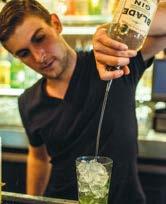

Indeed, the bar manager for Süda—a hip, half-year-old Pleasant Point restaurant named for the Estonian word for “heart”—tends living basil and mint plants right alongside his bottles of aromatic bitters and glasses stuffed with fresh citrus; he harvests the lavender that infuses one of his simple syrups himself. In fact, from the cilantro, basil and strawberries Süda raises on its own small farm in Corralitos to the other fresh fruit and vegetables delivered by Watsonville Produce, all of Süda’s ingredients come from around Santa Cruz, where 23-yearold Hickenbottom was born and raised.
Hickenbottom also aims to keep it local when it comes to the liquors Süda stocks, choosing to feature California spirits like TRU Organic Vodka and Blade Gin.
“The theme at Süda is farm-fresh, sustainable foods and staying local,” Hickenbottom says, referring to the restaurant’s creative
and eclectic menu. “We try to bring that home in the liquor domain as well.”

This means that, save for some staples, the cocktail menu is largely at the whim of the seasons—with fall came a pink peppercorn cosmo and home-batched spiced rum; blood oranges are featured prominently on the winter drink menu.
Hickenbottom keeps the classics in mind when concocting most of his cocktails. “When I have a drink at home, I’m making classic drinks,” he explains. “That’s what I like to drink—and that’s how I get inspiration for
restaurant, when they go into a bar,” Hickenbottom says. “I want people to realize that there is more out there than just your gin and tonic, that there is more out there than just your standard margarita.” He points to Süda’s Green Mary (made with tomatillo tomatoes that are fire-roasted with garlic and onion and a custom mix of spices, cilantro and basil) as an example of his quest to redefine the standards and raise expectations.
“People should be aware of what they’re buying and consuming” even when it comes to alcohol indulgences, Hickenbottom says. “We’re a good representation of what you can do with ingredients from the surrounding area.”
1½ ounces Blade Gin ½ ounce lavender simple syrup ½ ounce lemon juice 3–4 basil leaves 3 cucumber pieces, sliced into quarterinch thick discs Champagne-style sparkling wine
what I can change in the drink.” Two of the restaurant’s most popular cocktails embody this approach: The Süda 75 ($9), which incorporates basil, cucumber and lavender into the famous French 75, and the MadHattan ($11), which is an Alice In Wonderland-inspired twist on the ever-delicious Manhattan (take note: Süda also makes a mean top-shelf Manhattan). Hickenbottom’s MadHattan starts with a fiery absinthe rinse, which gives the drink an anise nose. Once the blue flames have coated the snifter, an ethereal mix of bourbon, blood orange liqueur and vermouth are poured in, releasing a light steam.
Hickenbottom earned his mixology stripes at the upstairs lounge at Downtown Santa Cruz’s Motiv, which is owned by Süda co-owner Mike Pitt, who also owns The Castaways bar. (Süda’s other owner is Daniel Voskoboynikov, who is also the proprietor of Harbor Cafe.)
“The overall goal at Süda is to change what people expect when they go into a
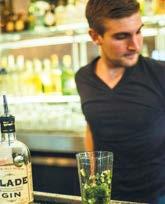
Lavender simple syrup Pick a handful of live flowering lavender. Remove the flowering bud from the stem until you have ½ to ¾ cup of flower tops.
In a saucepan, bring 6 cups of water to a boil then turn down heat to simmer. Add 6 cups of organic sugar (cane or raw). Stir until completely dissolved and the liquid has become transparent. Set heat to low and add lavender, stirring occasionally for the first 5 minutes. Remove saucepan from heat and let sit until mixture has cooled. Use a funnel with cheesecloth or a super-fine mesh strainer (bouillon strainer) to strain out the lavender. Refrigerate and enjoy for up to 3 weeks.
Muddle both basil and cucumber in a mixing glass. Add all additional ingredients and ice. Shake for 9–12 seconds until frost begins to form on shaker tin. Double-strain into a cocktail or wine glass. Add a light float of champagne style sparkling wine (brute) to taste. Garnish with a cucumber wheel. Enjoy!
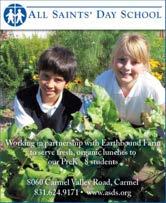
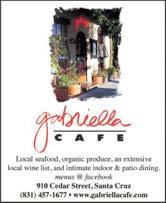
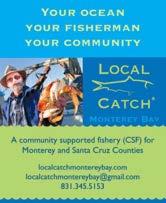






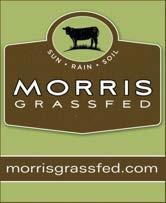


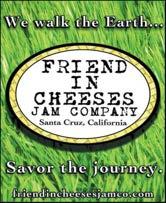
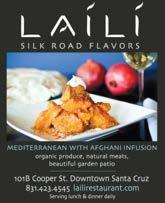
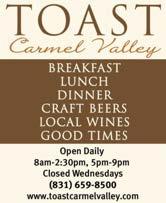
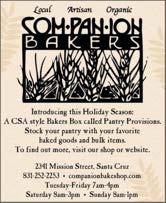

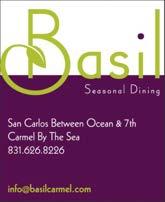

Carried Away


7564 Soquel Drive • 831.685.3926 www.carriedawayfoods.com
A cozy, green-certified take-out or eat-in café, Carried Away has a menu that changes weekly and features primarily organic, locally sourced ingredients. Owner/chef Tom McNary worked for many years at Chez Panisse and his dishes reflect the seasons. Soups, salads, entrees and desserts are all made fresh daily. Thin-crust pizzas available on Tuesday, Friday and Saturday. Open M–F 11am–7pm, Sa 11am–5pm, closed Su.
Sanderlings/Seascape Beach Resort
1 Seascape Resort Drive • 831.662.7120 www.sanderlingsrestaurant.com
With magnificent panoramic views of the ocean and the manicured grounds of Seascape Beach Resort, Sanderlings is a good choice for a daytime meal. Their wide selection of salads and seafood dishes features locally grown produce and fish that meets the Seafood Watch guidelines. Santa Cruz County wines are highlighted on the beverage list and Happy Hour on the patio from 3–7pm is an excellent value. Open daily for breakfast, lunch and dinner from 6am–midnight M–F and 7am–midnight Sa–Su.
The Restaurant at Ventana
48123 Highway 1 • 831.667.4242 • www.ventanainn.com
A peaceful fireplace setting and rustic wood interior give way to a legendary terrace with some of the most amazing views Big Sur has to offer. Chef Truman Jones’ cuisine uses fresh, seasonal and sustainable ingredients sourced from local farms and foragers and reflects his memories of growing up on a farm and his experience working in some of the world’s most-acclaimed restaurants. The menu changes frequently; the wine list is award-winning. The Ventana Bistro is available for private events. Open daily for breakfast 7:30–10:30am, lunch 11:30am–4:30pm, dinner 6–9pm.
New Leaf Community Market 13159 Highway 9 • 831.338.7211 • www.newleaf.com New Leaf offers some of the best fresh food made and grown here on the Central Coast. Made-to-order sandwiches, salads and hot foods are all natural. No nitrates, hormones, antibiotics or artificial ingredients. The Coastal Kale Salad is a big favorite; wide selection of picnic supplies to be found here, too. Open 9am–9pm every day.
New Leaf Community Market 1210 41st Avenue • 831.479.7987 • www.newleaf.com See description under Boulder Creek. Open 8am–9pm every day.
Whole Foods Market 1710 41st Avenue • 831.464.2900 www.wholefoodsmarket.com

Too busy to cook? Looking for a healthy eat-in café or source of picnic supplies? Head for the prepared foods section of Whole Foods Market, where everything is natural or organic and as much as possible is locally grown. There are ethnic specialties, salads, soups, fresh pizza and a coffee bar. Open 8am–9pm every day.
Basil Carmel
San Carlos Street between Ocean and Seventh avenues 831.626.8226 • www.basilcarmel.com
Locally sourced and seasonal aren’t just buzzwords at Basil. Chef/Owner Soerke Peters turns out beautiful dishes with intense flavors—like black squid ink linguine with sea urchin sauce and Monterey squid, or Monterey abalone in vermouth butter sauce on fingerling potato hash. This cozy restaurant in the Paseo Courtyard has heated outdoor seating. There’s a full bar and a good selection of California wines, including many organic or biodynamic choices. Lunch and dinner daily from 11:30am.




California Market at Hyatt Carmel Highlands
120 Highlands Drive 831.622.5450 • www.highlandsinn.hyatt.com
Locals and visitors alike enjoy the rustic elegance of this casual bistro. Whether dining al fresco overlooking magnificent Yankee Point or indoors by the pot-bellied stove, the California Market menu offers an eclectic array of offerings. At breakfast, look for frittatas, omelets, breakfast paninis, sticky bun French toast; lunch includes fresh seafood, pastas, sandwiches and daily specials. Service begins at 7am.
Carmel Belle

Doud Craft Studios • San Carlos Street at Ocean 831.624.1600 • www.carmelbelle.com
Passionate about sourcing the best local ingredients and meticulous about identifying them on the menu, Carmel Belle is a delicious choice for breakfast or lunch. Almost everything is organic, from the coffee to the meats and cheeses. Faves include a warm slow-cooked Berkshire pork sandwich with red onion-currant chutney on ciabatta, and their house-made mozzarella and asparagus panini. Open daily 8am–5pm.
Carmel Valley Coffee Roasting Co.
The Barnyard Shopping Village, 3720 The Barnyard 831.620.0844 • www.carmelcoffeeroasters.com
The only certified-organic coffee roasting company on the Monterey Peninsula, Carmel Valley Roasting Co. operates six coffeehouses and provides beans and coffee to area restaurants, hotels and markets. Owners Dean and Janet McAthie’s mission is to create superior, handcrafted coffee by roasting the finest Arabica beans in the company’s new Italian Farina coffee roaster. Each of their coffeehouses offers a unique experience, providing light fare such as bagels, pastries and sandwiches. Open M–F 6am–6pm, Sa 7am–5pm, Sun 7am–4pm.
Carmel Valley Coffee Roasting Co.
Crossroads Shopping Village, 246 Crossroads Blvd. 831.626.8784 • www.carmelcoffeeroasters.com
Open M–F 6:30am–6pm, Sa–Su 7am–6pm
Carmel Valley Coffee Roasting Co.
Mid Valley Shopping Center, 319 Mid Valley Center 831.622.0787 • www.carmelcoffeeroasters.com
Open M–F 6am–5pm, Sa–Su 6am–3pm
See description under Carmel for The Barnyard location
Carmel Valley Coffee Roasting Co.
Ocean Avenue between Lincoln and Monte Verde 831.626.2913 • www.carmelcoffeeroasters.com
Open Su–Th 6am–6pm, F–Sa 6am–7pm
See description under Carmel for The Barnyard location
Earthbound Farm’s Farm Stand Organic Kitchen 7250 Carmel Valley Road • 831.625.6219 www.ebfarm.com/OurFarmStand
Organic is essential at Earthbound Farm. In addition to fresh organic produce, prepared foods and gourmet groceries, the farm stand has a colorful salad bar and a certified organic kitchen. Under the direction of Executive Chef Sarah LaCasse, the kitchen turns out homemade soups and bakery goods daily. Take out or eat on site at tables set in the garden. The Farm Stand also hosts cooking demonstrations and other classes and activities. Open M–Sa 8am–6:30pm, Su 9am–6pm.
Junipero Avenue between Fifth and Sixth avenues 423.802.1230 • www.labalenacarmel.com
La Balena was set to open just after Edible Monterey Bay went to press with this issue. The plan was to offer rustic food in the spirit of a classical Enoteca. With a faithful authenticity to true Italian cuisine, the Bartolinis strive for excellence in all aspects of selection, preparation, and presentation of their dishes. They believe that food and wine taste better when served near where they are grown and when they are produced with ethical standards. Expect a menu that is simple and seasonal, featuring fresh foods with great flavor. Keep an eye on their website for an opening announcement and operating hours.
San Carlos Street between Ocean and Seventh 831.624.7400 • www.mundakacarmel.com
A convivial Spanish restaurant and tapas bar hidden away at the back of a Carmel courtyard, Mundaka is named for a coastal town in the Basque country and has a loyal following of locals. A surprisingly authentic kitchen led by Chef Brandon Miller produces organic specialties to share like patatas bravas, croquetas, tiny lamb chops and paella. Open for dinner 5:30pm–late every day.
Pacific’s Edge at Hyatt Carmel Highlands 120 Highlands Drive 831.620.1234 • www.pacificsedge.com
Hyatt Carmel Highlands offers awe-inspiring views of the Pacific, stellar service and food that draws inspiration from local farms and purveyors. Built atop a craggy cliff overlooking the dramatic Big Sur coastline, there is no better perch from which to view the setting sun or a breaching whale. Start your experience with a craft cocktail at the Sunset Lounge, followed by dinner in the glass-walled dining room at Pacific’s Edge (daily 6–9pm), featuring sophisticated California coastal cuisine from Chef Matt Bolton.
Rio
101 Crossroads Blvd. • 831.625.5436 • www.riogrill.com
The high-energy Rio features the talents of Chef Cy Yontz, who produces creative regional California cuisine and the flavors of the Southwest using bold spices and an oak-wood fire. The recently renovated bar offers elevated cocktails and an award-winning wine list, catalogued and annotated on iPads, which are handed to guests along with their menus. The new Barrel Room is available for private events. Open daily for lunch 11:30am–4:30pm, dinner 4:30–10pm and Sunday brunch 11:30am–3pm.
Lokal
13750 Center St., Carmel Valley Village 831.659.5886 • www.facebook.com/lokalcarmel
Chef Brendan Jones has no difficulty attracting full houses nightly. The ingredients for his exceptionally creative and sophisticated cuisine are sourced locally, and the inspiration, from Japan, Spain and other parts of Europe. Tuna x3, ceviche, roasted bone marrow and cabbage soup with mustard ice cream are not to be missed. Local wines and beer are poured at a 28-foot reclaimed wood bar. All food is organic when possible. Open for dinner Th–Sa 6pm, breakfast and lunch Tu–F 7am–3pm and Sa 9am–2pm.
Bernardus Lodge, 415 W. Carmel Valley Road 831.658.3595 • www.bernardus.com
Marinus has a new wine country-chic interior echoing the restaurant’s herb garden in its sage, lavender, burgundy and olive colors. It is a good fit for the stellar California cuisine of Chef Cal Stamenov, who loves searching out rare, highquality local ingredients—many of them now are grown in the restaurant’s 6-acre organic garden or brought in by local foragers. Private parties can book dinner in the award-winning wine cellar or at the chef’s table in the kitchen, where Julia Child and dozens of celebrities have dined. Open for dinner W–Su 6–10pm.
3 Del Fino Place, Carmel Valley Village 831.659.8500 • www.toastcarmelvalley.com


Whether you’re dining on the sunny deck out front or inside this spacious bistro decorated with the work of local art photographers like Kodiak Greenwood, the service and food are both excellent. Favorites are classic eggs benedict, a crab and spinach salad, sautéed salmon and marsala-glazed pork chops. Craft beer and local wine menus will impress the adults; rigatoni Bolognese and a toy basket will win over the kids. Open for breakfast and lunch 8am–2:30pm and dinner 5–9pm. Closed W.

Bernardus Lodge, 415 W. Carmel Valley Road 831.658.3400 • www.bernardus.com
Right next to the croquet lawn, the lodge’s more casual and economical dining option uses the same local organic produce and fresh seafood as Marinus in simpler preparations. Locals love to drop in for lunch on the sunny patio, ordering seasonal brick-oven pizzas, sandwiches, classic salads and light entrées. A 3-course dinner menu is available for $25 on Monday nights. Open daily for breakfast 7–11am, lunch 11:30am–3pm and dinner 6–10pm, with a light afternoon menu from 2–6pm.
Will’s Fargo Dining House & Saloon
16 W. Carmel Valley Road, Carmel Valley Village 831.659.2774 • www.bernardus.com/lodge/restaurants
Originally built as a tearoom in the late 1920s, this landmark steakhouse once served as a roadhouse on the “milk run” between Monterey and Tassajara. Purchased by Bernardus Lodge founder Ben Pon in 2002, Will’s Fargo is under the direction of super Chef Cal Stamenov, whose passion for high-quality, local ingredients shines through. Will’s caters to all tastes, focusing on natural beef, but providing lamb, fresh fish and vegetarian options as well. A lively bar next to the dining room keeps locals coming back for cocktails and camaraderie. Open for dinner Th–Tu 4:30pm, lunch F and Sa noon.
New Leaf Community Market
6240 Highway 9 • 831.335.7322 • www.newleaf.com See description under Boulder Creek. Open 9am–9pm every day.
Freedom Meat Lockers and Sausage Company

160 Hi Grade Lane • 831.724.4355 www.freedommeatlockers.com
Worth searching out for their natural home-smoked meats and sausages, this old-fashioned butcher shop also has a take-out deli with hot and cold sandwiches, side salads and homemade apple or berry pies from nearby Gizdich Ranch. Favorites include marinated tri-tip, skirt steak and pulled pork sandwiches. Gift packs and custom smoking of your fish or game is also available. Open Tu–Sa 9am–6pm, deli hours 10am–5pm.
New Leaf Community Market
See description under Boulder Creek. Open 8am–9pm every day.
Wild Thyme Deli & Café

445 Reservation Road • 831.884.2414 www.wildthymedeli.com

Chef Terry Teplitzky offers a dizzying array of influences on the menu at his quaint and cozy café. A tantalizing slate of salads includes everything from traditional tuna and Greek to Asian cabbage and Chinese noodle. Also on offer is some of the best mango-chutney-bursting curry chicken in the region. East Coast classics, such as massive submarines, housemade corned beef and pastrami, as well as great Jerseystyle cheesesteak might smack of fast food, but everything is prepared with organic, locally sourced ingredients. Open M–Sa 10am–5:30pm.
East Village Coffee Lounge 498 Washington St. 831.373.5601 • www.eastvillagecoffeelounge.com
Located in a historic stone building in downtown Monterey, the East Village offers some of the vibe of the gathering place for hip and artistic souls that is New York’s East Village neighborhood. The coffee is fair-trade and certified organic and the food—salads, soups, wraps, paninis and other sandwiches—is made from locally sourced ingredients and can be taken outside to café tables in the plaza out front. Live entertainment and a wide selection of imported loose teas, European beer and local wines are also offered. Open M–F 6am–10pm, Sa 7am–10pm, Su 7am–8pm.
Monterey Bay Aquarium Café and Restaurant 886 Cannery Row • 831.648.4870 www.montereybayaquarium.org
Sweeping views of the Monterey Bay are the focal point of the upscale restaurant inside the Aquarium. Executive Chef Jeff Rogers prepares sustainable seafood approved under the Aquarium’s Seafood Watch program. Preparations range from New England clam chowder to Thai-style mussels, with child-friendly options as well. Complimentary binoculars offered for viewing sea life in the bay. Open daily 11am–5pm. A self-service café is open 10am–5pm. Aquarium admission required.
Montrio Bistro
414 Calle Principal • 831.648.8880 • www.montrio.com This sophisticated bistro located in a historic brick firehouse in Old Monterey lures with a creative, seasonal menu created by Chef Tony Baker, a British expat with an eclectic style. Montrio’s faithful start early, enjoying the small-bite menu during happy hour at the lively bar—with a spirited, innovative cocktail program designed by mixologist Anthony Vitacca. Dinner begins at 5pm nightly, and patrons often linger well into the night. Montrio embraces sustainability, purchasing from local farms and vendors, following Seafood Watch guidelines and employing a triple-filtered tap water system.
731 Munras Ave. • 831.643.0300
539 Hartnell St. • 831.641.9188
Ryan Ranch, 40 Ragsdale Drive, Suite 100 831.655.3030 • www.parker-lusseaupastries.com
Gorgeous French pastries, cakes and tarts are lovingly handcrafted by the young couple that owns this gem of a bakery, Ann Parker and Yann Lusseau. If you want something hot from the oven, go to the Munras Avenue location where everything is baked. The Hartnell shop is a rustic café in a historic adobe in Old Monterey. Croissants, quiche, eclairs, cream puffs and chocolates are all on the menu, along with a selection of sandwiches, salads and soup. Custom cakes available for weddings and other special occasions. Munras store open W–Sa 7am-4:30pm. Hartnell store open M–F 7am-5:30pm and Sa 7:30am–4pm. Ryan Ranch store open M–F 7:30am–3pm.
Stone Creek Kitchen
465 Canyon del Rey Boulevard • 831.393.1042 www.stonecreekkitchen.com
A glass-walled kitchen in the middle of a spacious cookware shop turns out imaginative Mediterranean deli treats and sweets to take away or eat under the market umbrellas outside. Petite baguette sandwiches—like grilled chicken, artichoke hearts and Boursin cheese—are little works of art. Don’t miss the pistachio/cherry chocolate bark or the paella Fridays. Open M–F 10am–7pm, Sa 10am–4pm, closed Su except during November and December.
Tarpy’s Roadhouse

2999 Monterey Salinas Highway • 831.647.1444 www.tarpys.com This romantic, historic stone roadhouse—built in 1917 and set on five, beautifully landscaped acres—features dining in several semi-private rooms and on a cozy garden patio. Chef Michael Kimmel uses a wood-burning grill to prepare American country cuisine, including wild game, prime steaks and local seafood, daily from 4:30pm. A popular site for Sunday brunch (11:30am–3pm) and local weekday “power lunches” (11:30am–4:30pm), Tarpy’s also attracts a spirited bar crowd and is a popular spot for large banquets, meetings and celebrations.
Whole Foods Market 800 Del Monte Center • 831.333.1600 www.wholefoodsmarket.com See description under Capitola

The Haute Enchilada 7902 Moss Landing Road • 831.633.5843 www.hauteenchilada.com A fanciful world where Frida Kahlo and Andy Warhol prints hang side by side on fiesta-colored walls and a mermaid fountain gurgles in the courtyard, The Haute Enchilada serves Spanish, Mexican and Peruvian dishes with an emphasis on fresh seafood and local wines. Try salmon tacos with fruit salsa for lunch or chilaquiles for a hearty brunch. Open M–Tu 10am–4pm, W–Su 10am–9pm.
Carmel Valley Coffee Roasting Co. 510 Lighthouse Ave. 831.920.1663 • www.carmelcoffeeroasters.com Open daily 6:30am–6:30pm See description under Carmel for The Barnyard location
Happy Girl Kitchen Co.

173 Central Ave. • 831.373.4475 www.happygirlkitchen.com


The menu changes daily at Happy Girl’s airy and bright Pacific Grove café, but the food is always delicious, organic and reasonably priced. The sandwich of the day is $5.50 and a bowl of the soup of the day is $4.50. To drink, you’ll find kombucha on tap and Blue Bottle Coffee brewed fresh. Homemade baked goods include a daily scone, cookies and turnovers. When it’s time to go, take home some famed Happy Girl preserves or another local artisan food product from the café’s wide selection. Open daily 8am–3pm.
il vecchio

110 Central Ave. • 831.324.4282 www.ilvecchiorestaurant.com Fresh, authentic Italian pastas, entreés and desserts at affordable prices draw crowds nightly and create a festive atmosphere at Pacific Grove’s newest hotspot. The warm, rustic interior was created using reclaimed and salvaged materials by owner Carl Alasko’s daughter Ariele—a Brooklyn-based designer. Many of il vecchio’s recipes originated at Rome’s renowned Maccheroni trattoria. Now offering L’avventura in Cucina on Monday nights and family night on Tuesdays. Open Tu–Su 5–9:30pm.
La Crème Monterey/Crema 481 Lighthouse Ave. 831.375.1300 • www.lacrememonterey.com

By day an espresso bar and by night a tapas and wine bar, Crema is the creation of La Crème Catering’s Chef Jon Moser and owner/party organizer extraordinaire Tamie Aceves. Moser and Aceves have a dedication to fine organic and local ingredients worthy of the renowned kitchens where Moser worked previously, including those of Chez Panisse, the French Laundry and Manresa. Crema is located in La Crème’s new Casa de la Crème, a Victorian Mansionturned-event space, complete with outdoor garden seating. Espresso bar open daily from 7am; tapas bar open Th-Su 4–8pm.
Passionfish

701 Lighthouse Ave. • 831.655.3311 www.passionfish.net
If you’re looking for a restaurant with playful, spectacular food and a scrupulous commitment to sustainability, this green-certified restaurant is hard to rival. The elegant dining room is celebratory yet relaxed, and the award-winning wine list features many sustainable names and is priced at retail. Chef Ted Walter’s menu is ever-changing with the seasons, but always includes delicious organic local produce, inventive slow-cooked meats and an array of sustainable seafood choices. Open daily 5pm.
Point Pinos Grill 79 Asilomar Blvd. • 831.648.5774 www.ptpinosgrill.com

Now serving dinner! Despite being located near Point Pinos Lighthouse and adjacent to a golf course, Point Pinos Grill’s biggest draw is its food, thanks to Chef Dory Ford and his team from Aqua Terra Culinary. Breakfast and lunch classics get his sustainable, gourmet spin, like buttermilk blueberry pancakes made from scratch, heirloom tomato tart, or arugula, fig and prosciutto salad. Happy hour prices and appetizer supper specials start at 3pm. Open M–Tu 7am–5pm, W–Su 7am–8:30pm.

The Lodge at Pebble Beach 831.625.8519 • www.pebblebeach.com
The Bench offers contemporary internationally influenced cuisine prepared with wood-fired technique—and sweeping views of Stillwater Cove and the storied 18th hole at Pebble Beach Golf Links. The restaurant’s casual yet elegant dining room surrounds a showcase bar that is itself wrapped around the wood-fired oven. Beyond a glass-walled conservatory, The Bench also offers outdoor dining and fire pits. Chef Yousef Ghalaini, most recently Imperial No. 9 at New York’s Mondrian Soho Hotel, plans to draw heavily on local Monterey Bay ingredients to create his own grilled specialties. Expect inventive craft cocktails and the option to order large plates meant for sharing. Open daily 11am–11pm.
The Inn at Spanish Bay, 2700 17 Mile Drive 831.647.7433
www.pebblebeach.com/dining/the-inn-at-spanish-bay/peppoli-at-pebble-beach
The only restaurant in the U.S. associated with the Antinori Italian wine company, Pèppoli specializes in cuisine that goes well with its renowned Super Tuscan blends. There are homemade pastas and charcuterie and an enormous brick rotisserie in the dining room where prime rib sizzles on weekends, along with great sunsets overlooking Spanish Bay and Asilomar. Open daily 6–10:30pm.
The Inn at Spanish Bay, 2700 17 Mile Drive 831.647.7423
www.pebblebeach.com/dining/the-inn-at-spanish-bay/roysat-pebble-beach
With sweeping views over the wild Spanish Bay Golf Links to the coast, the Honolulu-based Roy’s features Hawaiian fusion fare. Chef Pablo Mellin combines Asian tastes and European technique to create exotic entrées like Crab Crusted Halibut or Thai Curry Glazed Rack of Lamb. Appetizers include 10 types of sushi rolls as well as nigiri sushi and sashimi. Open daily for breakfast 6:30–11am and for lunch and dinner 11:30am–10pm.
The Lodge, 2700 17 Mile Drive • 831.625.8524 www.pebblebeach.com/dining/the-lodge-at-pebblebeach/stillwater-bar-and-grill
A muted maritime theme with wavy designs and gleaming wooden decks sets off Stillwater’s magnificent views of Carmel Bay and the 18th hole at Pebble Beach Golf Links. Seafood dominates the menu. A live tank provides Monterey Bay red abalone and Maine lobster. Splurge on a shellfish platter of oysters, crab and prawns or try Pacific black cod with organic local vegetables. Open daily for breakfast, lunch and dinner M–Th 8am–9pm, F 8am–10pm, Sa 7am–10pm, Su 7am–9pm.
The Lodge at Pebble Beach
1700 17 Mile Drive www.pebblebeach.com • 831.325.8535
This “19th hole” is like no other course restaurant. Renowned for its extensive collection of prized golf memorabilia, it’s also famous for classic steaks and a warm tavern atmosphere. Open daily for lunch and dinner, it serves allAmerican fare—from burgers to prime rib to filet mignon—but chef Benjamin Brown helps lighten the experience with his use of produce from such local purveyors as Swank Farms.
Cascade Bar and Grill
Costanoa Lodge, 2001 Rossi Road at Highway 1 650.879.1100, x4 • www.costanoa.com

Just a short drive up a gorgeous stretch of coastline from Santa Cruz’ Westside, Cascade aims to reflect its setting in its food. New Chef Hunter Brawley has lightened and localized the menu, offering seasonally driven dishes featuring the harvest of Cascade’s garden and those of neighbors like Harley Farm and Swanton Berry Farm. He’s also put much more (sustainable) fish on the menu, including a rich cioppino, as well as a number of local, biodynamic and sustainable wines. Part of the Costanoa ecoadventure resort, Cascade can also offer diners a chance to spend the night. Open daily 7:30am–9pm.
The Bakery Station 202 Monterey St. • 831.783.1140 www.thebakerystation.com In a repurposed gas station, bakers Ana Melissa Garcia and Erika Olivarez fire up a traditional stone hearth oven to produce crusty Old World breads, scones and muffins. The Bakery Station is also a popular lunch stop, turning out sandwiches like the Road Hog—with pulled pork and whiskey sauce on a brioche roll. Open M–F 6am–4pm, Sa 7am–2pm, closed Su.
Charlie Hong Kong 1141 Soquel Ave. • 831.426.5664 www.charliehongkong.com Charlie Hong Kong has been providing the Santa Cruz community with healthy, fresh, high-quality food since 1998. The restaurant’s fusion of Southeast Asian influences and the Central Coast’s local organic produce is what has made it a neighborhood favorite. Its slogan is “love your body, eat organic,” and its cuisine is proof that fast food can be good for you. Open daily 11am–11pm.
Companion Bakeshop 2341 Mission St. • 831.252.2253 www.companionbakeshop.com

After five years on the farmers’ market circuit, Companion has opened its own bakery/café. It has a brick oven, where organic sourdough bread is baked throughout the day, and there is a long communal table for sharing a coffee with your neighbors. Eight kinds of sourdough bread and seasonal pastries are made with local, organic ingredients. Tuesday night is pizza night and Thursday, fish tacos. Open Tu–F 7am–1pm, Sa–Su 8am–2pm, closed M.
Gabriella Café 910 Cedar St. • 831.457.1677 • www.gabriellacafe.com
One of the city’s most charming dining spots, Gabriella Café serves a California-Italian menu starring organic produce from local growers and the nearby farmers’ market, as well as humanely raised meat and sustainable seafood. There is a candlelit patio and a cozy dining room that showcases the work of local artists. Open for lunch M–F 11:30am–2pm, dinner daily 5:30–9pm, brunch Sa–Su 11:30am–2pm.
Laílí
101B Cooper St. • 831.423.4545
www.lailirestaurant.com
Exotic flavors of the Silk Road are served in a stylish dining room decorated in eggplant and pistachio colors and on a hidden candlelit patio. Locals rave about Laílí’s homemade naan served warm from the oven with a selection of Mediterranean dips. There is a wide variety of deliciously spiced vegetable dishes, organic whenever possible, and all meats are hormone free and free range. Open daily for lunch 11:30am–3pm and for dinner 5–9:30pm.
538 Seabright Ave. • 831.457.2782

www.lapostarestaurant.com

A cozy neighborhood bistro not far from the Santa Cruz yacht harbor, La Posta Chef Katherine Stern prepares northern Italian cuisine using local ingredients—some foraged and some grown on nearby organic farms. Charcuterie is house-cured and the rest of the menu reflects whatever produce is freshest right now. Visit the chickens in the restaurant’s backyard and enjoy the eclectic atmosphere. Open Tu–Th 5–9pm, F–Sa 5–9:30pm, Su 5–8pm, closed M.
Le Cigare Volant


328 Ingalls St. • 831.425.6771 • www.lecigarevolant.com Chef Ryan Shelton serves some of the region’s most innovative cuisine in a warm dining room, with a wood-fired pizza oven in full view and a bar made from barrel slats. Taking full advantage of sustainably grown, organic local produce, meats and cheeses, the menu changes with the seasons. Small plates like smoked fingerling potatoes, flat bread pizza and pork shoulder steamed buns are always available in the wine tasting room. Open for lunch daily 12–6pm, tastings daily 12–5pm and dinner W–Su 5:30–9pm. Roswell hour: 51% off glasses of Bonny Doon wine Su–F 3–6pm.
New Leaf Community Market 1134 Pacific Ave. • 831.425.1793 • www.newleaf.com See description under Boulder Creek. Open 9am–9pm every day.
New Leaf Community Market 1101 Fair Ave. • 831.426.1306 • www.newleaf.com See description under Boulder Creek. Open 8am–10pm every day.
The Penny Ice Creamery 913 Cedar St. • 831.204.2523 www.thepennyicecreamery.com
Lines out the front door of its converted Spanish bungalow are evidence of Penny’s popularity. All ice cream, including bases, is made from scratch on the premises using local organic ingredients when possible. Flavors change seasonally, but two favorites are bourbon bacon chocolate and strawberry pink peppercorn. Open Su–W noon–9pm, Th–Sa noon–11pm.
The Picnic Basket 125 Beach St. • 831.427.9946 www.facebook.com/thepicnicbasketsc
Across the street from the main beach, owners of the Penny Ice Creamery have opened an alternative to boardwalk fast food. Sandwiches, organic salads, coffee and beer, all from local food artisans, and of course Penny’s popular ice cream are all on offer to eat in or eat outside with your feet in the sand. Open daily 7am–9pm.
Ristorante Avanti
1917 Mission St. • 831.427.0135
www.ristoranteavanti.com
This popular, Mediterranean-style bistro recently moved into a lush, more upscale location with a larger bar and expanded seating to better accommodate its loyal fans. Avanti’s menu remains true to its long-time commitment to supporting local organic farms as well as local ranchers, foragers and fishermen. The menu changes with the seasons and specials are offered every day using local organic produce and meats, wholesome oils and imported Italian cheeses. Open for lunch M–F 11:30am–2pm, for dinner Su–Th 5–9pm, F–Sa 5–9:30pm.
River Café

415 River St., Suite K • 831.420.1280 www.rivercafesantacruz.com
A popular spot for breakfast and lunch at the Old Sash Mill, the River Café now serves dinner on Thursday and Friday nights. All meals are made with seasonal, local and organic ingredients, prepared with a Mediterranean flair. Homemade granola and quality panini. Dine inside or on their redwood deck. Open M–Sa 6:30am–6pm, Su brunch 10am–4pm. Organic produce and flower stall open Tu 11:30am–4pm.
Soif Restaurant and Wine Bar 105 Walnut Ave. • 831.423.2020 • www.soifwine.com This wine-centric downtown restaurant is housed in a hip, loft-style building and includes a wine shop next door. Food reflects Chef Santos Majano’s love for Mediterranean flavors, and each dish is paired with a wine suggestion from the vast wine list. Monday evenings there is a raw oyster bar with live jazz. Tuesday is tapas night. Restaurant and wine bar open Su–Th 5–9pm, F–Sa 5–10pm.
Vivas Organic Mexican Restaurant
1201 Soquel Ave. • 831.425.8482 www.vivasorganic.com A splashing fountain suggests an old Mexican patio but the food is a modern, organic and delicious take on south-ofthe-border classics like tacos, tostadas, quesadillas and burritos. All meats and vegetables are organic. Local juices, organic white and brown rice are available, as well as vegan options. Open M–F 10am–10pm, Sa–Su 9am–10pm.
Whole Foods Market 911 Soquel Ave. • 831.426.9901 www.wholefoodsmarket.com See description under Capitola

Gizdich Ranch 55 Peckham Road • 831.722.1056 www.gizdich-ranch.com
Visitors from great distances love this third-generation, family-run farm business that popularized the “pik-yor-self” experience just east of Watsonville’s Interlaken neighborhood. Tour the farm, pick fresh apples or berries or watch the action inside the juice-pressing barn. No one leaves hungry if they spend time at the bakery-deli that pleases with its fresh pies, shortcakes and pastries, along with hearty sandwiches and box lunches. This family friendly experience is also a treat for kids, who will enjoy the wide-open spaces and the homemade popsicles and slushes. Open daily 8am–5pm.
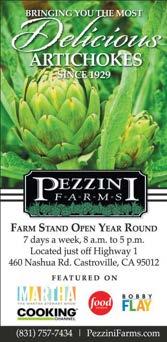


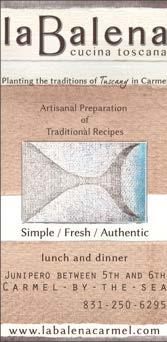

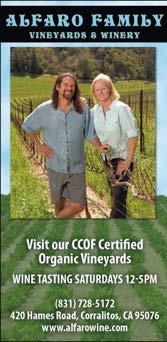


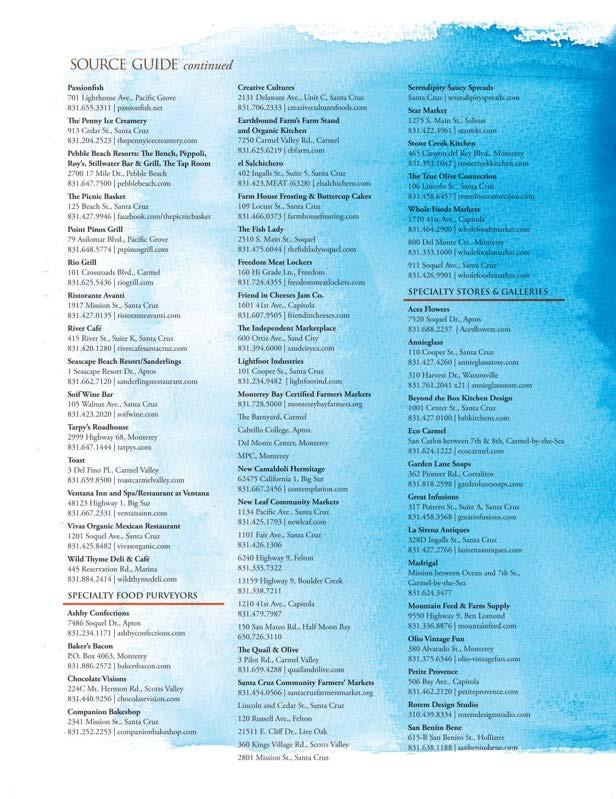

MARINA
Marina Certified Farmers’ Market
215 Reser vation Road
Marina Village Shopping Center 831.384.6961
Sundays, 10am–2pm • Open year-round www.everyonesharvest.org EBT/WIC
Monterey Fairgrounds
Certified Farmers’ Market
2004 Fairground Road, Gate 8 831.235.1856
Mondays, 9am–5pm • Open year-round
Monterey Certified Farmers’ Market
Monterey Peninsula College 980 Fremont Street, parking lot 831.728.5060
Fridays, 10am–2pm Open year-round, rain or shine cbarr@montereybayfarmers.org www.montereybayfarmers.org WIC

Old Monterey Market Place
Alvarado Street between Del Monte and Pearl • 831.655.2607
Tuesdays, 4–7pm (winter), 4–8pm (summer) Open year-round, rain or shine www.oldmonterey.org
Pacific Grove Certified Farmers’ Market
Central and Grand avenues, in front of Jewell Park 831.384.6961
Mondays, 4–7pm • Open year-round www.everyonesharvest.org EBT/WIC
Closter Park
401 Towt St. • 831.905.1407
Saturdays, 8am–2pm • Open year-round EBT/MIC
Salinas Old Town Marketplace
Alisal and Main streets behind Rabobank 831.905.1407
Saturday, 9am–2pm • Open year-round www.oldtownsalinas.com/market.asp EBT/WIC
The Independent Marketplace
600 Ortiz Ave. 831.394.6000
First Thursday of every month, 4–9pm Open year-round www.sandcityca.com
APTOS
Aptos Certified Farmers’ Market
Cabrillo College, 6500 Soquel Drive Cabrillo College, parking structure 831.728.5060 • Saturdays, 8am–12pm
Open year-round, rain or shine cbarr@montereybayfarmers.org www.montereybayfarmers.org EBT/WIC
SANTA CRUZ
Downtown Santa Cruz Farmers’ Market
Lincoln and Cedar streets 831.454.0566
Wednesdays, 1:30–5:30pm (winter) Open year-round, rain or shine www.santacruzfarmersmarket.org EBT/WIC
Live Oak/Eastside Farmers’ Market
21511 E. Cliff Drive
East Cliff Shopping Center 831.454.0566 • Sundays, 9am–1pm Open year-round, rain or shine www.santacruzfarmersmarket.org EBT/WIC
Westside Santa Cruz Market
2801 Mission St. at Western Drive 831.454.0566 • Saturdays, 9am–1pm
Open year-round, rain or shine www.santacruzfarmersmarket.org EBT/WIC
Watsonville Certified Farmers’ Market
Peck and Main streets • 831.234.9511
Fridays, 3–7pm, Sundays, 1–5pm Open year-round, rain or shine EBT/WIC
Watsonville Fairgrounds
Certified Farmers’ Market 500 Harkins Slough Road
Pajaro Valley High School • 831.235.1856 Saturdays and Sundays, 9am–4pm Open year-round

